This paper investigates a well-known but rare icon from the rock art of the Atacama Desert. It concerns a group of anthropomorphic figures displaying a very specific bird-related element. For that reason Juan Chacama and Gustavo Espinosa speak of ‘hombres-falcónidas’, ‘raptor-men’, to describe this class of anthropomorphic figures. Remarkably, their interpretation seems to be generally ignored by several archaeologists and rock art investigators. This study presents a revaluation of the theory put forward by Juan Chacama and Gustavo Espinosa in 1997.
By Maarten van Hoek
The Avian Staff Bearer
Upgrading a Controversial Icon in Atacama Rock Art
Posted January 2016 – Updated May 2016 (Ariquilda and Conanoxa)
*
Maarten van Hoek – rockart@home.nl
This paper originally is illustrated with 127 photographs, drawings and maps. About half of those illustrations appears in this on-line issue of TRACCE (click any illustration to enlarge, click again or use the back-arrow to go back), while the complete set of illustrations appears in an (also updated – May 2016) PDF that can be downloaded via Academia.
Introduction
This study challenges and refutes the idea – focussing on one specific Andean rock art icon – that it is not scientifically correct to accept biologically impossible representations of biomorphs, especially of combinations and/or conflations of (elements of) zoomorphs and anthropomorphs in rock art. Instead, I argue that, when – for instance – an ancient civilisation depicts a human figure emerging from the head of a bovine (Figure 1), this must be accepted as meaningful and as their reality; not as a scientific biological reality, but as a scientific cultural reality.
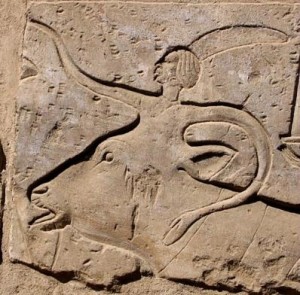 Figure 1. Human emerging from the top of the head of a bovine. Part of a frieze at the Temple of Luxor, Egypt. Photograph © by Maarten van Hoek.
Figure 1. Human emerging from the top of the head of a bovine. Part of a frieze at the Temple of Luxor, Egypt. Photograph © by Maarten van Hoek.
Click on any illustration in this article to get a larger picture (click the < back arrow [top left] or – in some cases – click on the illustration to return to the article). Click the hyperlinks (in underlined red) to go to other web pages, which will open in a new window (click the X icon [top right] to return to the article).
In this respect this study analyses the distribution and meaning of a specific but still controversial rock art image that is mainly found in the Atacama Desert west of the High Andes of South America. It concerns an anthropomorphic rock art image that is often said to have been derived from well known Tiwanaku iconography, although this study questions this claim. A specific element of this anthropomorphic figure is generally accepted by Chilean archaeologists to represent a kind of garment. Consequently it is often referred to as a ‘skirt’. However, Chilean archaeologist Juan Chacama once claimed that this element symbolised the wings of a bird and that the icon represented a human-bird conflation. Unfortunately his claim does not seem to have been accepted by several Chilean archaeologists.
In this study I offer new evidence and compelling arguments, together with more examples of this type of anthropomorph, which collectively will underpin the theory first put forward by Juan Chacama (and later jointly with Gustavo Espinosa). Unfortunately, some Chilean rock art researchers confine their surveys to only rock art zones in Chile. Therefore, most of the evidence comes from rock art sites in northern Chile, but there is also evidence available across the border. For that reason my Study Area is larger than the Chilean Atacama and includes the deserts of southern Peru as well (which are a continuation of the Atacama).
The extent of the Study Area (Figure 2) is determined by the occurrence of a specific rock art image that I have labelled the Avian Staff Bearer in this analysis. The Study Area is quite large and stretches from San Pedro de Atacama in the Norte Grande of Chile to the Río Majes in southern Peru, a distance of roughly 930 km (via the sites mentioned in this study). As the site that is located farthest inland is found up to 220 km from the coast, the Study Area roughly covers an area of 200.000 km2. The altitudes range from near sea-level to as high as 3500 m O.D., thus excluding the archaeological complex of Tiwanaku (which is at 3864 m and 270 km inland). Although important in this study, Tiwanaku is located outside our Study Area for a reason explained later on.
Figure 2. Map of the Study Area with the sites relevant to this study marked with squares (explained further down in the text). Map © by Maarten van Hoek (updated May 2016), based on Google Earth Relief Maps.
The Study Area mainly consists of the driest desert in the world, the Atacama Desert, which extends further north well into the south of Peru, while the highest areas of the desert mingle with the austere Altiplano of the High Andes. Those two areas are clearly distinguishable in the map of the Study Area (Figure 2).
All altitudes, distances and most UTM coordinates in this study are based on Google Earth (2015: please note that locations may alter in satellite photos of earlier or later dates). The accuracy of those UTM coordinates is explained by stating the feature or the radius in which the rock or site is located. For example, when the Bloque is mentioned the accuracy is 100 %; the rock is (almost) exactly located at the given coordinates. When a village, the area or a radius (e.g. 10 m) is mentioned the accuracy is less than 100%.
It is obvious that rock art is found on natural solid rock surfaces. This seems to be a simple statement, but thus a geoglyph cannot be regarded to be a form of rock art and yet many researches consider geoglyphs to represent true rock art. However, I do not accept geoglyphs to be a form of rock art; it is a form of art arranging small rocks and gravel or sand. Different terms applied for a rock are often equally confusing. Especially in Chilean publications about rock art the Spanish term “Bloque” has often been used. In many cases this term refers without any distinction to (panels on) outcrops as well as to (panels on) loose boulders. This is strange as several Chilean publications also use the term “afloramiento” to specifically refer to rock art panels on outcrops. In this study I will state (whenever possible) whether the rock art is found on an outcrop or on a boulder. When I have access to ‘officially’ published inventories or any other kind of official numbering information, I will use the existing term (mainly ‘Bloque’) to refer to the established numbering of the boulders and/or outcrop panels (for instance: Site Az-29 – Bloque 04B). When I have no information about the numbering of the rocks, I will use the term Boulder or Panel and will use my own numbering (for instance: Boulder ARQn-085).
Another problem concerns the description of (variants of) the anthropomorphic figure that is the subject matter of this study. Archaeologists often use different terms to describe some of those figures as well as several related images, which can be very confusing. Based on specific elements those specific anthropomorphic figures have been described as ‘Personaje Frontal de Cabeza Radiada’ or ‘Ser Antropomorfo con Tocado Dentado’ (Frontal Figure with Radiate Head), ‘Personaje Frontal con Cetros / Báculos’ (Front-facing Staff-bearing Deity) and ‘Personaje Sacrificador’ (The Sacrificer). Other terms that are associated with similar rock art figures are ‘Caravanero’, ‘Hombre-cóndor’, ‘Tunupa’, ‘Señor de La Isla’, ‘Icono de Chorrillos’, ‘Señor de los Báculos’ and ‘Ser Mítico’ (La Isla and Chorrillos being place-names in northern Chile). Importantly, one or more graphical elements of all the figures mentioned in this paragraph may be present in one exclusive anthropomorphic figure – the subject of this study. Unfortunately, one of those elements is often too easily accepted to represent a ‘skirt’.
Indira Montt (2002), specifically discussing anthropomorphic (rock art) figures bearing skirts in northern Chile speaks of ‘la imagen antropomorfa con Faldellín’ (the anthropomorphic figure with a ‘skirt’) and she distinguishes four categories of ‘skirts’: 1: ‘Faldellín Segmentado’; 2: ‘Faldellín Segmentado Continuo’; 3: ‘Falda Continua’ and – the focus of this study – 4: ‘Faldellín Desdoblado’. This last category cannot be easily translated with only two words, but the best attempt would be: bisymmetrical skirt.
This study only discusses images that fit into the fourth category; the so-called ‘bisymmetrical skirt’. These are images that comprise only fully frontally depicted anthropomorphic figures with two (mainly horizontally arranged) elements that are emerging from the hip area. In fact, in this study the focus is mainly on only one type of the fourth category of ‘skirts’ (that are not specified by Montt), the elements of which Helena Horta (2004: 66) describes as ‘las flecaduras a la altura de las caderas’ (the fringes at the height of the hips). Indira Montt (2002) moreover argues that those elements represent a sort of pubic covering and that they are the only (!?) piece of clothing that those figures are wearing. However, these purported ‘fringes’ also look very much like the wings of a bird and if so, the figures might even be unclothed.
In this respect Indira Montt (2002: 18) remarks in footnote 10: ‘Este faldellín desdoblado fue llamado por Chacama y Espinoza (1997: 784) “faldellín alado”, siendo considerado por estos autores como la “síntesis de las alas de un ave”,….. which translates as (my additions between [ ]): ‘This ‘Faldellín Desdoblado’ was labelled by Chacama and Espinoza (1997: 784; [2005]) “winged skirt”, because the authors considered it as the “synthesis of the wings of a bird”…. So far so good, but unfortunately Indira Montt continues to say that ‘…. perspectiva que este estudio [Montt 2002] no comparte por tratarse, entre otros argumentos que podrían ser esgrimidos, de un elemento fijado a la figura antropomorfa a la altura de la cintura y no de los hombros’ which, freely translated, reads: ‘I [Montt 2002] do not share their opinion, because, among other arguments that could be put forward, it concerns an element attached to the anthropomorphic figure at the height of the waist, not the shoulders’. Unfortunately she does not mention the ‘other arguments’, which would possibly have been more revealing. For several reasons I disagree with her argument and her consequent conclusion to refute and ignore the interpretation by Chacama an Espinosa. In PART II I will challenge her line of reasoning, reassessing and supporting the theory put forward by Juan Chacama and Gustavo Espinosa.
Indeed, as early as 1997 Chilean archaeologists Juan Chacama and Gustavo Espinosa interpreted those purported ‘pubic’ elements as the wings of a bird. It is even possible that Juan Chacama launched his ideas earlier, in an MS dated 1995. Strangely, their very plausible theory never seems to have been accepted (see Montt 2002: footnote 10) despite the fact that Juan Chacama in a later publication (MS apparently written in 2000 and re-published twice in 2004) convincingly argued again that – also because of the wing-elements – the anthropomorphic figure with the purported ‘pubic fringes’ was strongly bird-related, especially to bird imagery at the petroglyph site of Ariquilda-1, and persuasively expressed bird-symbolism that is related to shamanic beliefs in general. Juan Chacama speaks of ‘hombres-falcónidas’, ‘raptor-men’, to describe this class of anthropomorphic figures. The fact that Chacama, using the term ‘raptor-men’, seems to exclude the possibility that those figures are female, is irrelevant in this study. This study now aims at reinforcing their hypothesis by offering ‘new’ evidence and ‘new’ theories. Also important in this respect is that the issue is put in a broader Andean context.
The Avian Staff Bearer
Juan Chacama regards certain images in Atacama rock art to represent conflations of anthropomorphs and birds, and indeed, several examples are most convincing. Those ornitomorphic images can thus be regarded as therianthropes, or rather, as avianthropes; figures expressing the concept of avianthropy: the power of a human being to transform into a bird, or to gain bird-like characteristics. Several images from Atacama rock art are said to represent conflations of humans and birds, like the (in my opinion less convincing) rock painting of an ‘Hombre-Condór’ at Alero Zurita (Figure 3) in the valley of the Río Loa and at least six (according to Cabello and Gallardo 2014: 16; Fig. 5C) petroglyphs at Tamentica-1 in the Huatacondo Valley (Figure 4). However, in general those images show more birdlike characteristics than anthropomorphic properties. Moreover, those conflations generally have wings emerging from the shoulders, although there are also rock art images of conflations of humans and birds without wings (Aguayo Sepúlveda 2008: Fig. 10).
Figure 3. Rock painting from Alero Zurita, Río Loa, Chile. Drawing by Maarten van Hoek, based on a photograph in Berenguer 1999: 35.
Figure 4. Petroglyphs from Tamentica-1, Chile. Photograph © by Maarten van Hoek. Please note that all photos in this study (may) have been digitally improved by the author. Moreover, any error in any of the illustrations is the sole responsibility of the author.
However, the specific human-bird conflation Juan Chacama speaks of is a clearly anthropomorphic figure with extensions from the hip area that indeed much resemble the stylised wings of a bird. In fact, in Andean rock art bird-wings are usually depicted this stylised way. In order to distinguish those anthropomorphic images from the ‘shoulder-wing’ type and from many other differently labelled figures I decided to label this group of human-bird conflations ‘Avian Staff Bearers’ in this study, even though many of such anthropomorphic figures do not necessarily bear staffs (báculos) or sceptres (cetros) or anything else. It must be emphasised however that – in my opinion – the Avian Staff Bearer is not the same figure as the Front-facing Staff-bearing Deity (Personaje Frontal con Cetros / Báculos) mentioned above, which is – for matters of convenience – referred to in this study simply as the Staff Bearer.
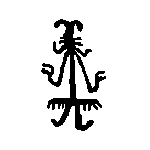 Characteristics of the Avian Staff Bearer
Characteristics of the Avian Staff Bearer
There are certain essential characteristics that define the image of the Avian Staff Bearer. Such images predominantly have an anthropomorphic appearance and they always concern standing figures with two arms and two legs, even when – as seems the case in some instances – legs have not been indicated clearly. However, when legs are ‘absent’, the figure may be seated or it may have been depicted with unfinished legs or with minimised legs.
Importantly, Avian Staff Bearers are always depicted fully frontally and symmetrically, which means that they may be mirrored horizontally along their vertical axis, disregarding however occasional minor details that may disturb (often on purpose) this horizontal symmetry. The fingers emerging from the ‘hands’ of the arms are often represented by only two or three lines that quite regularly are arranged parallel to the imaginary ground surface. Most importantly, in this study true Avian Staff Bearers (Types A1 and A2) always show two essential elements: (1) the wing-shaped extensions from the hips and (2) the W-shaped configuration of the arms (or one or two V-shaped arms).
There are however many variations of the Avian Staff Bearer that are mainly determined by secondary characteristics like a head with short radial grooves (the radiant head type). Another variant is the type with short appendages from the head that are arranged in three separate groups of parallel lines. Other examples clearly hold staffs or comparable straight, vertically arranged objects that are held parallel to the body.
In a few cases there is a circle or circular dot attached to the elbow of each V-shaped arm (the nadir of the V). These circular elements are regarded to symbolise ‘trophy’ heads as some images of the Staff Bearer show heads, apparently human, dangling from the elbows (the reason to in general hyphenate the term ‘trophy’ was explained by me earlier [Van Hoek 2010]). This specific feature may be an indication that the (Avian) Staff Bearer sometimes may represent a conflation between the Staff Bearer and the Decapitator or Sacrificer; another important Pan-Andean personage.
Based on those characteristics I will now present a classification and an inventory of the Avian Staff Bearer (Types A1, A2 and A3) and many other possibly related (and often fully frontally depicted) anthropomorphic figures (Types B and C), without pretending however that every Andean rock art image will have been considered.
Avian Staff Bearer Type A1: This type of Avian Staff Bearer has two mandatory properties. It always features the two wing-shaped elements from (near) the hips (the minimum number of downward pointing lines at each element is two). Moreover, the W-shaped arms always hold a ‘staff’ or a comparable object in each hand. However, those objects do not need to be held or even touched by the hands of the Avian Staff Bearer. They may ‘float’ a short distance from the hands/fingers, but they must always involve (more or less) straight objects that are (more or less) vertically arranged, parallel to the body and often to each other. Secondary elements may include a radiant head and/or ‘trophy’ heads from the elbows, all or some of which may be absent or present.
Avian Staff Bearer Type A2: This type always features the two wing-shaped elements from (near) the hips. The arms are always W-shaped. Secondary elements may include a radiant head and/or staffs and/or ‘trophy’ heads from the elbows, all or some of which may be absent or present.
Avian Staff Bearer Type A3: This type always features the two wing-shaped elements from (near) the hips. The arms are not W-shaped, but instead both arms may be drooping, horizontally arranged, raised (the ‘surrendering’ position) or even absent. Avian Staff Bearers of Type 3 in the saluting position (one arm raised; the other drooping) are very rare, but at least one example seems to occur on Outcrop ARQs-073 at Ariquilda-1. Secondary elements may include a radiant head and/or staffs and/or ‘trophy’ heads from the elbows, all or some of which may be absent or present.
Anthropomorph Type B: This type features two elements from (near) the hips that are often horizontally arranged, mostly parallel to the imaginary ground surface. However, these are no specific wing-elements. The elements emerging from the hip area have a (completely) different character, or – when only simple horizontal lines are present – the minimum of two short, downward pointing lines is absent. Therefore, in this study Type B is not classified as a true Avian Staff Bearer. Importantly however, the arms may be W-shaped, although other positions also occur. Arms may even be absent. Other secondary elements may include a radiant head and/or staffs and/or ‘trophy’ heads from the elbows, all or some of which may be absent or present.
Anthropomorph Type C: This type includes all other possibly related anthropomorphic figures. They may involve standing or seated figures without extensions from (near) the hips (and definitely no wing-elements). Their arms are often W-shaped (allowing for other positions as well, though). Arms may even be absent. They may have a radiant head and/or staffs and/or ‘trophy’ heads from elbows.
Archaeological Sites with (Avian) Staff Bearer Imagery
Significantly and surprisingly, the overall number of images of the Avian Staff Bearer proves to be extremely small in Andean rock art. Also the number of archaeological sites where the image has been recorded (on rock surfaces or on artefacts of textile, wood and metal) is rather limited. In this respect I would like to emphasise that not all rock art sites in the Study Area have been fully inventoried and that I definitely have not surveyed all rock art sites in the Study Area. Therefore there may be more sites with images of the Avian Staff Bearer that are unknown (to me), while also known sites may have more images (often hard to recognise due to size, weathering and superimposition). Moreover, rocks once bearing images of the Avian Staff Bearer may have been destroyed (for instance at Tamentica). Nonetheless, with the following inventory of sites with Avian Staff Bearer imagery the minimum distribution of the image will become evident.
This list with archaeological sites with Avian Staff Bearer imagery has arbitrarily been arranged from south to north and the sites have been indicated in Figure 2 with yellow squares that are numbered from 1 to 15. These 15 sites represent fixed images and – except for Site 7, marked with a blue square, which is a geoglyph site – all sites represent rock art sites (as explained earlier I do not regard geoglyphs to be a form of rock art). Also the often mobile artefacts in the Study Area have been arranged on the map from south to north. They have been marked in Figure 2 by green squares and indicated by capital letters B to E. Item A, the archaeological site of Tiwanaku, is located far to the east of the Study Area on the Altiplano of the Andes. For matters of convenience on this study I do not distinguish between the geographical term Tiahuanaco (or Huari) and the cultural term Tiwanaku (or Wari). A number of possibly related rock art sites that are mentioned in this study, appear as red squares in Figure 2. When necessary their location will be indicated from the nearest rock art site (1 to 15) or by Google Earth UTM coordinates, or their names will be mentioned in some of the detail-maps.
Item A: Tiwanaku (Gateway of the Sun – UTM: 534784.67 E – 8169712.62S). The first item is a huge, artificially constructed monument at the archaeological site of Tiwanaku, Bolivia (3864 m O.D. and 270 km inland). Although possibly not at the original location, this ‘Gateway of the Sun’ features one of the best known sculptures of the Staff Bearer. There are more important Tiwanaku-Style sculptures at this site – for instance the Ponce Monolith – and at other Tiwanaku-Style sites on the Altiplano. Yet, none of the sculptured Staff Bearer figures found at Tiwanaku or the Altiplano can be regarded to represent true Avian Staff Bearers. But still their purported relation with the Avian Staff Bearer is said to be relevant and for that reason Tiwanaku comes first in this inventory.
Mobile Item B: Quitor (Pucara de Quitor – UTM: 580534.87 E – 7468312.65 S). Crossing the natural border of the Andes, including enormous stretches of high plains, salt pans, active volcanoes and deep gorges, we arrive in the Atacama Desert. It is said that at one time the influence of Tiwanaku finally reached the desert area around the village of San Pedro de Atacama. In this area several artefacts with imagery of the Staff Bearer have been excavated (López 2007). I only mention one of those artefacts as an example. It is a wooden snuff-tablet from the archaeological site of Quitor-5 (2490 m O.D. and 212 km inland), which was used to inhale hallucinogens from. It features an image that is clearly related to the Staff Bearer at Tiwanaku (Figure 5). But the question – to which I will return later on – is, which element is older: the Quitor artefact or the Tiwanaku sculpture? Importantly, as far as I know, no artefact with an image of the Avian Staff Bearer was ever excavated in the area.
Figure 5. Image on a wooden snuff tablet from Quitor-5, Chile. Drawing by Maarten van Hoek, based on a drawing in López 2007: 15. The colours have been added arbitrarily to better distinguish several features.
Avian Staff Bearer – Site 1: Vilama Sur (Area – UTM: 585603.00 E – 7473051.00 S). This site is found somewhere along the banks of the Río Vilama, a short distance NE of the village of San Pedro de Atacama (approximately 2570 m O.D. and 218 km inland). Very little has been published about the Avian Staff Bearer at this site and the only published illustration that I could find (Montt 2002: Fig. 21) is too small and too vague to be scientifically useful, while, unfortunately, also an explanatory text is lacking completely. I wrote several Chilean archaeologists to get (literally and metaphorically) a better picture of this petroglyph, but not one scholar answered. In the end I wrote the officials behind the ‘archivo visual proyecto FONDECYT 1000148’, Archivo Nacional de Chile (ARNAD), but in the long run they answered that they ‘could not find’ the original photograph in their archives (sic!).
From the only published photo it seems that the petroglyph is found on a smooth and flat (probably vertical) outcrop. The photo very vaguely shows a wing-element emerging from the left hip; the right-hand element is too faint to be visible (Figure 6). Although the same ambiguity goes for the other properties, it seems that this Avian Staff Bearer is of the A1-Type. Importantly, this river valley is said to have been one of the oldest caravanning routes from the Atacama to the Altiplano by Gonzales Pimentel (2008), who – remarkably – does not mention this specific petroglyph.
Figure 6. Petroglyph on a rock surface along the Río Vilama, Chile. Drawing by Maarten van Hoek, based on a photograph in Montt 2002: Fig. 21. My drawing is only very sketchy and will no doubt be inaccurate or even incorrect.
North of San Pedro de Atacama are the well known petroglyph complexes of Yerbas Buenas (YB). At Sites YB-1 and YB-2 are several panels with most idiosyncratic anthropomorphic figures (all males?). Most of them appear to be naked and sitting and all have a radiant head with three separate groups of parallel lines. Only one of the ten sitting examples on a large, vertical outcrop panel at Site YB-2 (YB-2, Bloque 1-4 [UTM: 578672.25 E and 7492711.27 S]; sometimes referred to as the ‘Altar de las Budas’; Tamblay 2005; 2006; or as ‘Los Shamanes’), has its arms in the W-shaped position (yellow arrow in Figure 7). At Site YB-1 are several panels with similar figures, (yellow arrows in Figure 8) some of which seem to be standing, but clearly display W-shaped arms, like the examples on outcrop panels Site YB-1, Bloque 7-1 (UTM: 578511.74 E and 7492055.63 S) and YB-1, Bloque 2-9; and on a large boulder at Site YB-1, Bloque 3-1. Further south and SE, on the Piedra de la Coca (Tamblay 2005; 2006) and in the Quebrada de Quesala respectively, similar ‘Budas’ have been reported. However, none of those ‘Buda’ petroglyphs represents an Avian Staff Bearer.
PDF-only -Figure 7. Petroglyph on Panel YB-2, Bloque 1-4 at Yerbas Buenas, Chile. Photograph © by Maarten van Hoek. Notice the two very large camelid petroglyphs (heads indicated by blue arrows).
Figure 8. Petroglyphs on Panel YB-1, Bloque 7-1 at Yerbas Buenas, Chile. Photograph © by Maarten van Hoek.
Mobile Item C: Chorrillos (Area – UTM: 510392.65 E – 7518628.65 S). Very near the town of Calama on the Río Loa is the archaeological site of Chorrillos (approximately at 2330 m O.D. and 140 km inland). One of the finds in this ancient cemetery was a textile fragment with a very distinct image of the Avian Staff Bearer belonging to the A2-Type (Figure 9).
Figure 9. Image of an Avian Staff Bearer on a textile from Chorrillos Cemetery, Chile. Drawing by Maarten van Hoek, based on a drawing in Horta 2004: Fig. 6a.
A panel at the rock art site of Yalquincha (Loa Medio – LM01) – located near Chorrillos in a gorge just east of Calama – features a small anthropomorph of about 20 cm in height. Although Bárbara Cases and Indira Montt (2013: Fig. 11d) draw the figure with one arm only, it is V-shaped and holds a vertically arranged straight object, possibly a staff. Unfortunately they do not explain whether this figure concerns a petroglyph or – which is more likely – a rock painting. At the same site there are at least two more rock paintings of anthropomorphic figures that have affinities with the Staff Bearer (Gallardo et al. 2012: Figs 3E and 7E), one with possible extensions from the hip that unfortunately have faded over time (Figure 10).
PDF-only – Figure 10. Rock painting of a possible Staff Bearer on a panel at Yalquincha, Chile. Drawing by Maarten van Hoek, based on a photograph in https://vimeo.com/58500046 (author unknown).
A petroglyph in the Study Area (similar to the image at LM01, thus possibly also from the Loa area) depicts an anthropomorph of the C-Type with W-shaped arms that are holding a staff each (Sepúlveda and Valenzuela 2012: Fig. 27.7b). Unfortunately, the authors do not state the location of this image.
Avian Staff Bearer – Site 2: Chiuchiu (Area – UTM: 536926.93 E – 7533455.89 S). Further north, a long stretch on the east bank of the Río Loa (on average at 2590 m O.D. and 165 km inland) has numerous boulders detached from the cliffs and outcrops that have rock art (mainly petroglyphs and a much smaller number of rock paintings). Chiuchiu is a most interesting site, but many panels are difficult of access because of the steep slopes that are covered with loose sands (Figure 11). Although no true Avian Staff Bearer image is known at Chiuchiu, there are several related figures, all of the (possibly) A3, B or C Type (illustrated in: Rojas 2005: 27, 28, 30, 53, 73, 78, 93, 98, 117 and 118).
PDF-only – Figure 11. View of the Loa Valley from Panel LA-55 at Chiuchiu, Chile (looking south). Photograph © by Maarten van Hoek. Chilean investigators have indelibly painted the numbers on the petroglyph panels, which should be avoided at all times.
On Bloque LA-72 in the Lucho Sector is a strange anthropomorphic petroglyph, possibly of the A3-Type (Figure 12); notice the position of the arms and the two fingers), while adjacent is Bloque LA-73 with a possible Staff Bearer.
Figure 12. Petroglyph on Panel LA-72 at Chiuchiu, Chile. Drawing © by Maarten van Hoek.
Also many unregistered panels occur at this site. At least three rock paintings with anthropomorphic images of the C-Type occur in the Lucho Sector. One small rock painting is found on an unclassified boulder (Rojas 2005: 74); two others are found on the wall of a shallow, concave rock shelter at a very high position (roughly at 2608 m O.D.). In the Chacras Viejas Sector is one petroglyph of a possible Avian Staff Bearer of the A3-Type (Figure 13). It has W-shaped arms bearing staffs, a radiant head and a small extension from one of the hips (a rudimentary or unfinished wing-element?). In the same sector is a huge boulder with a small petroglyph that possibly represents a Staff Bearer. Another large boulder nearby bears a large petroglyph of an anthropomorph with W-shaped arms, but apparently without legs. Moreover, in all three sectors at Chiuchiu there are several other C-Type petroglyphs, all with W-shaped arms.
PDF-only – Figure 13. Petroglyph on a panel at Chiuchiu, Chile. Drawing by Maarten van Hoek, based on a drawing in Rojas 2005: 104.
Especially important is the Bloque LA-24 in the Pona Sector of Chiuchiu. The north facing panel (thus facing an impressive row of volcanoes, one of which – San Pedro (Figure 14) – is still active) of this huge boulder features no less than three anthropomorphic petroglyphs of the C-Type. Importantly, although all three are Staff Bearers (Van Hoek 2001), none has the specific wing-element from the hips. However, the most interesting figure has two large snake-like elements emerging form each side of the hip area (Figure 15).
PDF-only – Figure 14. The impressive and still active volcano of San Pedro, looking east from inside the Quinchamale Gorge, Chile. Photograph © by Maarten van Hoek.
Figure 15. Petroglyph on Panel LA-24 at Chiuchiu, Chile. Drawing © by Maarten van Hoek.
Avian Staff Bearer – Site 3: Alto Loa (Area – UTM: 541868.80 E – 7582518.48 S). Further north along the Río Loa (on average 3140 m O.D. and 163 km inland) are several rock art sites with imagery related to the Avian Staff Bearer. This large rock art concentration may have originated because of the presences of the still active volcano of San Pedro, which towers over the region, its 6145 m high summit located only 20 km east of the Loa Valley (see Figure 14). At La Isla a petroglyph of a Staff Bearer with a very complex facial pattern and holding two staff-like objects (one possibly showing feathers; darts?) in his right hand has been reported (Berenguer 1999: 30), while at the same site two petroglyphs of the Staff Bearer occur; one seated on a two-headed camelid (Berenguer 1999: 29). A comparable petroglyph, together with other images of the C-Type, has been recorded at Angostura (Zurita), a rock art site located a little further north on the Río Loa.
A well known rock painting from La Bajada – still further north on the Río Loa – concerns a C-Type of the Avian Staff Bearer (Figure 16). Apparently it is seated, but possibly the legs are missing or only depicted very short (Berenguer 1999: 31). The horizontal bar may symbolise the extensions from the hip or it may represent the (folded?) legs. Importantly it has two ‘trophy’ head elements dangling from its elbows.
Figure 16. Rock painting from La Bajada, Río Loa, Chile. Drawing by Maarten van Hoek, based on a photograph in Berenguer 1999: 31.
Another rock painting possibly from the La Bajada site features an anthropomorph of the A3-Type. It has two extensions from the hip area and has two raised arms holding diagonally arranged (mirrored) objects (Figure 17).
PDF-only – Figure 17. Rock painting from La Bajada, Río Loa, Chile. Drawing by Maarten van Hoek, based on a photograph by Ximena Jordán.
PDF-only – Figure 18. Rock painting from Site 2-231, Río Loa, Chile. Drawing by Maarten van Hoek, based on an illustration by C. Sinclaire in Montt 2002: Fig. 20.
PDF-only – Figure 19. Rock painting from Site LS-061, Río Loa, Chile. Drawing by Maarten van Hoek, based on a drawing in Cases and Montt 2013: Fig. 16.
On outcrop Panel 7 of Site 2-Loa 231 is a rock painting of an A2-Type Avian Staff Bearer without the vertically arranged staffs, but with the purported ‘trophy’ heads dangling from the elbows (Figure 18). Unfortunately the head is not visible (Montt 2002: Fig. 20). Site LS-061 in the same area features an image of about 84 cm in height of an A1-Type of the Avian Staff Bearer. Its legs are either very short or, alternatively, it concerns a seated figure (Figure 19). The staffs nearby are slightly undulating (Cases and Montt 2013: Fig. 16) and may be serpent-related. In the same area more related rock art images have been recorded (Gallardo et al. 2012: Fig. 3B, Figs 7C and D).
A petroglyph of a purported seated figure has been recorded from the Toconce River valley (Area – UTM: 578954.43 E – 7533316.33 S), about 40 km east of Chiuchiu (Gallardo et al. 1999: 83). It has W-shaped arms and a radiant head. The figure is much related to similar petroglyphs at Yerbas Buenas. In the same area, at the Incahuasi Inca Site in the Caspana River valley (Aguayo Sepúlveda 2008: Fig. 28) and near Likan (Aguayo Sepúlveda 2008: Fig. 38), a site close to the village of Toconce, are several rock paintings that seem to represent Staff Bearers. In the same area are a rock painting of a possible A3-Type Avian Staff Bearer and a C-Type anthropomorph (Montt 2002: Fig. 6 and Fig. 7 respectively).
Avian Staff Bearer – Site 4: Tamentica-1 (Bloque 25 – UTM: 481968.90 E – 7681791.54 S). This small rock art site (at 1730 m O.D. and 100 km inland) with a mixture of loose boulders and outcrop panels has sadly been damaged violently very recently. This site is said to have 80 Bloques with altogether 186 panels. Directly opposite Tamentica-1 are the rock art sites of Tamentica-2 and 3. Further east in the Huatacondo Valley (Figure 20) are more rock art sites like Palta Cruz-1 and 2, Chele-1, 2 and 3, San Isidro and Tiquima (locations approximately indicated with red squares in detail-map Figure 21). Further west are the ruins of the prehistoric settlement of Ramaditas where two petroglyph (?) blocks have been built into one of the structures (Van Hoek 2011b).
Figure 20. View of the Huatacondo Valley, Chile, looking NE. Photograph © by Maarten van Hoek.
Figure 21. Map of the Tamentica – Cahuisa area, Chile. Map © by Maarten van Hoek, based on Google Earth (Google Earth Relief Maps).The yellow line indicates the major caravan-route across the Atacama leading to the oasis of Pica (further north; not on map).
Gloria Cabello and Francisco Gallardo (2014) have carried out a study regarding three specific images occurring at Tamentica-1, one of which is called ‘El Ser Antropomorfo con Tocado Dentado’, the ‘Anthropomorphic Being with Dentate Headdress’. They equate this image with ‘El Personaje de los dos cetros’ or ‘El Personaje frontal’. They state that there are ten (or 9 ?) such images at Tamentica (2014: Tabla 1): 4 on Bloque 25; 1 on Bloque 31 and 4 on Bloque 32), five of which show W-shaped arms. Four of those five images can be mirrored symmetrically. Remarkably they also state that only one petroglyph shows the ‘Falledín Desdoblado’, while in fact there are definitely two examples; both of the A2-Type and both appearing close together on Bloque 25 – Panel D; the best (uppermost) example (Figure 22) standing next to two anthropomorphic bird images (see Figure 4). The lowermost example (Figure 23) is rather faint, but is clearly illustrated by Grete Mostny Glaser and Hans Niemeyer Fernández (1983: Fig. 52).
Figure 22. Avian Staff Bearer on Bloque 25 – Panel D at Tamentica-1, Chile. Photograph © by Maarten van Hoek.
Figure 23. Avian Staff Bearer on Bloque 25 – Panel D at Tamentica-1, Chile. Photograph © by Maarten van Hoek.
On the same boulder is an anthropomorphic figure with W-shaped arms with dots below each elbow (‘trophy’ heads?) sitting (?) on a vertical bar, and apparently not showing legs (Figure 24). However the vertical bar may represent the (folded) legs or the wing-elements. It is said to be one of the ten (?) Radiant Head images (Cabello and Gallardo 2014), but true linear appendages from the head are not (no longer?) clearly visible at present. This figure (of the C-Type) may be compared with a rock painting from La Bajada (see Figure 16) on the Río Loa (118 km to the SE).
Figure 24. Petroglyph of a seated (?) figure on Bloque 25 – Panel D at Tamentica-1, Chile. Photograph © by Maarten van Hoek.
Also on Bloque 25 – Panel D is a very large Radiant Head Anthropomorph, apparently without arms but with three horizontally arranged appendages from each side of the hip (Figure 25). It may be compared with a similar, armless anthropomorphic petroglyph on (outcrop?) Panel ARQn-132 at Ariquilda-1, 152 km north of Tamentica (see Figure 55). Also at Ariquilda-1 is a boulder (exact location unknown) with a similar (anthropomorphic?) petroglyph (unfortunately damaged: parts have flaked off). This example seems to have short W-shaped arms and a similar pattern of short, parallel lines emerging from the hips (see Figure 56).
PDF-only – Figure 25. Petroglyph of an armless figure on Bloque 25 – Panel D at Tamentica-1, Chile. Photograph © by Maarten van Hoek.
Figure 26. Petroglyph of an anthropomorphic (?) figure on Bloque 32 – Panel A at Tamentica-1, Chile. Photograph © by Maarten van Hoek.
There are more possibly related figures at Tamentica-1. On Bloque 32 – Panel A is a doubtful anthropomorphic petroglyph (Type-B) with drooping arms and extensions from the hip area (Figure 26).
On Bloque 7 – Panel C is a profusion of images. At the top of this panel, centrally positioned, is a bird petroglyph (Figure 27) with a long serpentine line between the short legs, which is typical for several bird petroglyphs in this area (I will return to this feature). Of possible interest are the wings that are not curved as is often the case but straight (like the wing-elements of Avian Staff Bearers) and instead of short lines representing the feathers, there are rows of small triangles. Similar horizontally arranged lines with rows of triangles (wing-symbolism?) occur on the same panel, as well on Bloque 25 – Panel D. Importantly, to the right of the bird is an anthropomorphic figure that has W-shaped arms, while to its left is a biomorphic figure that has digits from its ‘arms’ and ‘legs’ that are arranged in the same way as in many Avian Staff Bearers (Figure 28).
Figure 27. Petroglyphs of a bird and an anthropomorph on Bloque 7 – Panel C at Tamentica-1, Chile. Photograph © by Maarten van Hoek.
PDF-only – Figure 28. Petroglyphs of a bird, an anthropomorph and a biomorph on Bloque 7 – Panel C at Tamentica-1, Chile. Drawing © by Maarten van Hoek.
Mobile Item D: Huatacondo-1 (Ancient settlement – UTM: 469926.00 E – 7678517.00 S). Interestingly, only 12 km west of Tamentica-1 are the well preserved ruins of a prehistoric settlement (Huatacondo-1; at 1375 m O.D. and 88 km inland). In their study of rock art in Chile Grete Mostny Glaser and Hans Niemeyer Fernández include a photo of a gold object that has been found in a tomb very near those ruins (1983: Fig. 111). It proved to represent a Type-A2 Avian Staff Bearer, without the staffs, however (Figure 29).
Figure 29. Gold object representing the Avian Staff Bearer from a tomb near the ancient settlement of Huatacondo-1, Chile. Drawing by Maarten van Hoek, based on a photograph in Mostny and Niemeyer 1983: Fig. 111.
Avian Staff Bearer – Site 5: Cahuisa-7 (UTM according to Ocampo 2007: 489956.00 E – 7700362.00 S). This petroglyph site, with (only?) one decorated boulder, was discovered during archaeological surveys in the area just north of the Quebrada de Cahuisa, probably in 2005. The site is located at about 2656 m above sea level and about 110 km inland. The panel, probably a large boulder, was found near a west facing rocky cliff of ignimbrite offering good views all around.
Among the images are rows of fully pecked camelids featuring four legs and schematic and linear camelids with two legs. In addition there are anthropomorphic figures associated with camelids, geometric figures like meandering lines, open triangles, two short parallel lines and dots. The surveyors (Ocampo 2007: 301) state that the imagery is reminiscent of that at Tamentica (located only 20 km to the SW) and hence many of the images are said to date from the Archaic or Early Formative Period.
Most important however in the scope of this study are three large petroglyphs representing scavenger-birds. Those birds are said to be associated with a number of camelid images that are however invisible in the photos they provided (Ocampo 2007: 302-303). They moreover interpret the ‘scene’ as scavenger birds prowling on camelids. They further argue that the scene is probably associated with a ritual to protect the camelids from their natural enemies (Ocampo 2007: 302). Yet, the surveyors argue that the camelids, which have been executed in a different technique than the birds, appear to be older. If this is true, then this probably is an instance of a possible ‘superimposed scene’. More importantly, the surveyors failed to notice a most significant characteristic of one of the bird petroglyphs, which I will discuss later on. Indeed, all three petroglyphs depict birds, but one ‘bird’ petroglyph is most idiosyncratic (see Figure 114) and this ‘bird’ will play an important role in the re-evaluation of the Avian Staff Bearer.
Avian Staff Bearer – Site 6: Duplijsa: (Radius 10 m – UTM: 462133.00 E – 7779323.00 S). About 50 m south of the Quebrada Guata-Guata (part of the Parca drainage) and east of the Questa Duplijsa mountain range are two groups of petroglyph boulders (at 1964 m O.D. and 80 km inland). East of Duplijsa are more rock art sites like Quebrada de Imagua, Chunchuja, Ozcuma, Tacaya, (Pucara de) Jamajuga or Cerro Gentilar, Tasma and Noasa. Also a few geoglyph sites are found in this rather high area. Duplijsa may be part of a route from Tarapacá-47 (at 1440 m O.D.) to the area around the village of Mamiña. This route, indicated by a number of geoglyph sites (marked with their altitudes in Figure 30: 1575, 1853, 1733 and 2428), seems to end at the petroglyph site of Pucara de Jamajuga (marked 2865 in Figure 30).
Figure 30. Map of the Duplijsa – Ariquilda area, Chile. Map © by Maarten van Hoek, based on Google Earth (Google Earth Relief Maps).
One group at Duplijsa has four boulders; the other has two. As I have not visited the site, I assume that the images that are relevant to this survey are found on the larger boulder of the second group (labelled Boulder DUP2-001 by me). This boulder has at least four panels with petroglyphs that all have weathered considerably (hence the uncertain nature of my drawings).
The SE facing and much sloping Panel DUP2-001A (Figure 31) has at least one A3-Type Avian Staff Bearer (Figure 32). However it does not represent the standard Avian Staff Bearer as it has an outlined, circular body with two parallel grooves emerging from both sides, while inside the body is a small cross-like design (a stylised bird?). From the shoulders two wings are held upright and in between is a bird-like head. Remarkably, from the hips two extra wing-elements, which are so characteristic for the Avian Staff Bearer, emerge. The legs/feet are human-like.
PDF-only – Figure 31. Petroglyphs on Panel A of Boulder DUP2-001 at Duplijsa, Chile. Drawing by Maarten van Hoek, based on a photograph by Vivencias a Color.
Figure 32. The Avian Staff Bearer on Panel A of Boulder DUP2-001 at Duplijsa, Chile. Drawing by Maarten van Hoek, based on a photograph by Vivencias a Color.
On the vertical, north facing Panel DUP2-001D (Panel C concerns the slightly sloping upper surface and Panel B is a small east facing, vertical panel) are three petroglyphs of Avian Staff Bearers, all of the A3-Type (Figure 33). Two figures have both arms raised (one showing bird-like feet), while the third example has straight, outstretched arms each holding a straight object; staffs? Most interestingly, this last figure has four wing-shaped elements emerging from the hip area and it has bird-like feet.
Figure 33 Avian Staff Bearers on Panel D of Boulder DUP2-001 at Duplijsa, Chile. Drawing by Maarten van Hoek, based on a photograph by Nativo Tour Chile.
Avian Staff Bearer – Site 7: Cerro Unitas (Geoglyph – UTM: 433705.00 E – 7794034.00 S). Although I do not consider geoglyphs to be a form of rock art, geoglyphs in general and this example in particular are most important in (Andean) rock art studies. The biggest geoglyph at Cerro Unitas (located at 1245 m O.D. on an isolated low hill and 52 km inland) concerns an immense anthropomorphic figure of about 90 m in height (Figure 34). It is oriented to the WSW (azimuth 248 degrees) and is best appreciated from above (Figure 35). It clearly is an Avian Staff Bearer of the B-Type as it has no true wing-shaped elements. The resemblance between this geoglyph and a petroglyph at Ariquilda-1 was already noted by Johan Reinhard as early as 1983.
PDF-only – Figure 34. The geoglyph on Cerro Unitas (within the yellow circle) looking NE towards the Sacred Mountain of Tata Jachura, Chile. Photograph © by Johan Reinhard. Information in his photo added by the author.
PDF-only – Figure 35. The enormous geoglyph on Cerro Unitas, Chile. Photograph based on Google Earth.
The appendages from the head of the geoglyph are not arranged in a radiant way, but more resemble the three arrangements of separate parallel lines found on the heads of several anthropomorphic petroglyphs at Yerbas Buenas (335 km SSE). Interestingly, also at Toro Muerto in southern Peru (510 km NW) is a small anthropomorphic petroglyph that has a radiant head (Figure 36) comparable with the Cerro Unitas geoglyph. However, anthropomorphic petroglyphs with comparable headdresses are also found at Yonán in northern Peru (1735 km NW of Cerro Unitas), so there is always a chance of chance.
PDF-only – Figure 36. Petroglyph on Boulder Cc-005 at Toro Muerto, Peru. Photograph © by Maarten van Hoek.
It is often said that the Avian Staff Bearer geoglyph at Cerro Unitas is unique. Although this is true, there are some comparable geoglyphs (without, however, any wing-element) much further NW. Those anthropomorphic geoglyphs are located in the desert around Illapata, SW of the Peruvian town of Palpa and outside our Study Area. Two geoglyphs are found at UTM: 479172.48 E – 8388658.46 S; one of which is incompletely illustrated by Ana Nieves (2007: Fig. 6.23). A single geoglyph [with darts and spear-thrower?] is found at UTM: 481114.00 E – 8386121.00 S. They all wear a strange ‘hat’ (comprising two groups of parallel lines) on a head that has facial features that are comparable with the Cerro Unitas anthropomorph. Most importantly, two figures have W-shaped arms holding one or two staff-like objects (Figure 37). Further NE, also in the Palpa Area, are at least two anthropomorphic petroglyphs with W-shaped arms (one with a staff in each hand), while further SE in the Ingenio Valley is a life-size, but much weathered anthropomorphic petroglyph that resembles the geoglyphs.
PDF-only – Figure 37. Geoglyphs near Palpa, Peru. Photograph based on Google Earth.
PDF-only – Figure 38. Part of the petroglyphs on an outcrop panel at Pachica, Chile. Drawing by Maarten van Hoek, based on a photograph by Aventura Tarapacá.
Avian Staff Bearer – Site 8: Chusmiza-3 (Radius 30 m – UTM: 478840.13 E and 7821922.36 S). East of Cerro Unitas is the archaeological complex of Tarapacá-47 (at 1440 m) with more than 400 boulders with petroglyphs of which 260 depict anthropomorphs; none depicting, however, any Avian Staff Bearer image or any other example of some related imagery (Núñez 1965; Núñez and Briones 1967-8). Further NE is Pachica (Brant 2008) with – among other panels – an enormous outcrop (at 1695 m O.D.) covered with numerous petroglyphs, the whole looking more like a panel with geoglyphs (Figure 38). But – again – none of the petroglyphs at Pachica is reported to depict the Avian Staff Bearer. Moreover, the area around Tarapacá-47 and Pachica is literally teeming with geoglyphs (only a limited number of geoglyph sites have been marked – with blue squares – in Figure 30). Much further NE is the petroglyph site of Parcollo, also not including any Avian Staff Bearer image (Núñez 1965; exact location of the site unknown to me and therefore most likely incorrectly indicated with 2520 in Figure 30).
Most important is the archaeological complex at Chusmiza, with – according to Flora Vilches Vega (2006) – 178 panels of petroglyphs. The site of Chusmiza-3 (at 3231 m O.D. and 100 km inland) is found in a 240 m deep canyon, only about 30 m south of the Quebrada de Ocharaza. The petroglyph sites of Chusmiza-1 and 2 (Valenzuela Ramírez 2010: Lámina 21) are found in and near two ancient structures further south, on top of a ‘low’ hill and 50 m higher up (Figure 39). Chusmiza-3 comprises a group of petroglyph panels at a lower level, one of which is decorated with one of the most sophisticated rock art images of the Avian Staff Bearer of the A1-Type (see Figure 39). Most important are the two staffs that look like spear throwers (atlatls). I will return to this petroglyph in PART II.
Figure 39. View of the archaeological complex at Chusmiza, Chile. Looking SE. Photograph © by Rolando Ajata. Information in his photo added by the author. The location of Chusmiza-3 is only approximated. Inset in yellow: the Avian Staff Bearer at Chusmiza-3. Drawing by Maarten van Hoek, based on a photograph by Gustavo Moscoso.
There are more possibly relevant images at Chusmiza. The upwards facing but much sloping panel of a large boulder at Chusmiza-1 has a small petroglyph of an isolated anthropomorphic radiant head with facial features (Vilches 2006: Fig. 3; Vilches and Cabello 2011: Fig. 6-C11). It looks much like the head of the Avian Staff Bearer at Chusmiza-3 and the head of the geoglyph at Cerro Unitas. Panel 138 has a petroglyph of possibly (part of) a winged figure with a radiant head without facial features (A in Figure 40, which slightly differs from the rendering by Paulina Chávez [Vilches and Cabello 2011: Fig. 3-C9]). Very near it on the same panel is a second, comparable petroglyph – also a radiant head? – again without facial features (B in Figure 40).
PDF-only – Figure 40. Details of some petroglyphs on Panel 138 at Chusmiza, Chile. Drawing by Maarten van Hoek, based on a photograph in Valenzuela Ramírez 2010: Lámina 22.
Importantly, at Chusmiza is also a petroglyph of an ornitomorphic figure (Vilches and Cabello 2011: 47; Fig. 6-E2) that has wings from the shoulder, but a body that is similar to the body of the Avian Staff Bearer at Chusmiza-3. Similar similarities between bird petroglyphs and images of Avian Staff Bearers have been noted by Juan Chacama also at Ariquilda-1.
 Avian Staff Bearer – Site 9: Ariquilda-1 (Panel ARQn-085 – UTM: 449824.53 E and 7830788.91 S). The petroglyph site of Ariquilda-1 (at about 1720 m O.D. and 73 km inland; see Figure 30) comprises a roughly two kilometre long stretch in the Quebrada de Aroma with numerous decorated cliffs and boulders that are found at both sides of the valley. The pink-red volcanic rock is very suitable to create petroglyphs upon. Yet, the prehistoric manufacturers clearly favoured the more deeply patinated surfaces.
Avian Staff Bearer – Site 9: Ariquilda-1 (Panel ARQn-085 – UTM: 449824.53 E and 7830788.91 S). The petroglyph site of Ariquilda-1 (at about 1720 m O.D. and 73 km inland; see Figure 30) comprises a roughly two kilometre long stretch in the Quebrada de Aroma with numerous decorated cliffs and boulders that are found at both sides of the valley. The pink-red volcanic rock is very suitable to create petroglyphs upon. Yet, the prehistoric manufacturers clearly favoured the more deeply patinated surfaces.
To the west of this petroglyph site and higher up on the Pampa are extensive areas with geoglyphs (at 1805 m O.D.), all fully described by Luis Briones Morales and Juan Chacama Rodriguez (1987). However, none of the geoglyphs represents an Avian Staff Bearer or a related figure. Only Geoglyph 33 in Panel 3 depicts an anthropomorphic figure holding a straight, vertical object, possibly a throwing-spear (Figure 41). Other geoglyph sites in the Atacama also include anthropomorphic figures holding staff-like objects (most likely weapons) but none seems to be related to the Avian Staff Bearer.
PDF-only – Figure 41. Geoglyph 33 in Panel 3 at Altos de Ariquilda Norte, Chile. Drawing by Maarten van Hoek, based on a drawing by Briones & Chacama 1987.
Unfortunately, a scientific inventory of the nearby petroglyph site of Ariquilda-1 has never been made available for non-academics (and possibly never will), although Juan Chacama confirmed me that there exists such an inventory at the Universidad de Tarapacá at Arica (2011: pers. comm.; see also Van Hoek, M. 2013b). For that reason, regrettably my record of Avian Staff Bearers and related imagery present at Ariquilda-1 will be incomplete. Moreover, I will have to use my own numbering. Panels on the south side are labelled ARQs (Ariquilda-Sur) by me; those on the north side ARQn (Ariquilda-Norte). A map indicating many of the panels in this gorgeous gorge appears in a video that is especially dedicated to Ariquilda-1. This video can be watched by clicking the blue thumbnail-URL below.
To visually support this paper about the Avian Staff Bearer, I have uploaded a video onto YouTube that offers more and different graphical information about Ariquilda than is offered in this publication. The video is in Spanish (please excuse any error) in order to reach especially people in Southern America. You can watch the video using the graphical link below, or, alternatively, you may prefer to click the following link (YouTube) so that the video appears next to the TRACCE publication.
Juan Chacama (2000 MS) states that Ariquilda-1 has 323 Bloques with petroglyphs. A map indicating the official numbering of a few Bloques at Ariquilda-1 is given in Figure 42. However, as explained the term Bloque may involve one boulder or an outcrop comprising of one or (many!) more panels. He moreover states that altogether there are 3623 petroglyphs, of which 855 comprise anthropomorphic images, while at least 176 petroglyphs depict birds. Also remarkable and significant are the many images of ‘solar’ petroglyphs at Ariquilda-1 (unfortunately not counted by Chacama [2000], though).
PDF-only – Figure 42. Map of the rock art site at Ariquilda-1, Chile, showing the official numbers of some of the Bloques. Drawing © by Maarten van Hoek, based on the map in Espinosa 1996: Fig. 2.
Figure 43. Map of the rock art site at Ariquilda-1, Chile, showing the (often much) approximated locations of the petroglyph panels mentioned in this study. Drawing © by Maarten van Hoek, based on Google Earth.
Of the 855 anthropomorphs only 20 are said to show a ‘skirt’ or ‘belt’, but as Chacama does not illustrate all 20 examples, it is impossible to tell exactly how many true Avian Staff Bearers (of the A1, A2 or A3-Type) are present and how many figures are of the B-Type or C-Type. Even Juan Chacama may have missed some petroglyph panels (see for instance Figure 68). Notwithstanding this dearth, I have a pretty good idea what is present at Ariquilda-1, as I have a graphic record of at least 30 panels with (Avian) Staff Bearers and possibly related images. The map of the area (Figure 43) shows the (often much approximated) location of 26 of those panels, indicating with green squares the position of 11 panels with true Avian Staff Bearer petroglyphs. It proves that there is a slight preference for the western part of the valley.
While Juan Chacama (2000: 15) states that there are no staff-like objects depicted in the rock art Ariquilda-1, there are several anthropomorphic petroglyphs that have ‘staffs’. Remarkably, Juan Chacama even illustrates at least four petroglyphs from Ariquilda-1 of anthropomorphs that clearly hold ‘staffs’ (Figure 44A, B, C and E). Several of those ‘staffs’ look more like ‘clubs’. At least one of the Avian Staff Bearer petroglyphs at Ariquilda-1 holds similar club-like objects (see Figure 68).
PDF-only – Figure 44. Some of the Staff Bearer petroglyphs at Ariquilda-1, Chile. Drawing by Maarten van Hoek, based on drawings in Chacama 2005: Figs 2, 4 and 10.
In his paper (2000) he moreover illustrates several petroglyphs that I could not trace in any of the graphic information that I have available. Therefore their locations are unknown to me. Of interest is the petroglyph illustrated in Figure 45A. The figure clearly has W-shaped arms with possible ‘trophy’ head extensions. The elements that emerge from the hips are not wings but S-shaped devices. Also an anthropomorphic image of an Avian Staff Bearer on a loincloth from Topater-1 near Calama features similar S-shaped elements from the hips (Horta 2004: Fig. 6b). I would like to argue here that they possibly symbolise ‘staffs’, because an anthropomorphic petroglyph at Tamentica-1 holds similar S-shaped objects in its V-shaped (not W-shaped) arms. However, Juan Chacama illustrates another Avian Staff Bearer (of the C-Type) which holds objects that are only slightly S-shaped (Figure 45C). Thus they could equally symbolise (transformed?) spear-thrower devices.
Figure 45. Some of the Avian Staff Bearer petroglyphs at Ariquilda-1, Chile. Drawing by Maarten van Hoek, based on drawings in Chacama 2005: Figs 2, 4 and 10.
Panel ARQn-085: Indeed, perhaps the best known rock art site regarding the Avian Staff Bearer is Ariquilda-1, and it certainly is the site with one of the most impressive images of the Avian Staff Bearer. Probably for that reason the hypotheses put forward by Juan Chacama and Gustavo Espinosa are mainly based on this image and the many other related figures at this site. There will be probably (many) more Avian Staff Bearers and related figures at Ariquilda-1, but they often are hard to recognise being much weathered, indistinguishable because of superimpositions or because of unfavourable lighting conditions. Some petroglyphs at this site have also been altered or added in recent times, although – fortunately – vandalism is almost absent at this site (but it does occur).
This ‘best’ example of the Avian Staff Bearer (Figure 46) is found on the north bank near the west end of the gorge (approximate location indicated in Figure 43). It is found on a projecting outcrop (Panel ARQn-085) with a flat surface that rather steeply slopes in some southerly direction (Figure 47). All views to the east are completely blocked. Probably because of the superimpositions on this panel and the weathered nature, the drawings of this petroglyph published by several authors may differ in detail. As it bears no ‘staffs’ and as there are no vertically arranged objects in its immediate neighbourhood, it clearly belongs to Type-A2. The figure (Figure 48) measures approximately 125 cm in height (Reinhard 1988: Fig. 36) and thus probably is one of the largest Avian Staff Bearer petroglyphs of the Study Area (I have not measured most of the Avian Staff Bearer petroglyphs in the Study Area). Notice the upward pointing triangular ‘fingers’ and ‘toes’; features that occur in other (Avian Staff Bearer) petroglyphs at Ariquilda and in the rest of the Study Area.
Figure 46. The Avian Staff Bearer on Panel ARQn-085 at Ariquilda-1, Chile. Photograph © by Johan Reinhard (digitally enhanced by the author).
Figure 47. The Avian Staff Bearer on Panel ARQn-085 at Ariquilda-1, Chile. Photograph © by Maarten van Hoek.
PDF-only – Figure 48. The Avian Staff Bearer on Panel ARQn-085 at Ariquilda-1, Chile. Drawing by Maarten van Hoek.
Although Juan Chacama does not include facial features in his illustrations of this figure, it seems that these features (rectangular eyes and mouth) are present after all, although indeed they are only very faintly visible. The same goes for the circular appendages of the elbows. The one dangling from its right-hand elbow is clearly visible; the other is much more obscured.
Panel ARQn-081: A short distance SE of Panel ARQn-085 is Panel ARQn-081 with a possible example of the Type-A3 Avian Staff Bearer. It is much weathered.
Panels ARQn-089 and 168: A short distance NW of Panel ARQn-085 is the heavily decorated Panel ARQn-089. It has a possible example of the Type-A3 Avian Staff Bearer (Figure 49). It has triangles possibly representing ‘feathers’. Also its arms/hands are formed by triangles. Immediately east of this large panel is a much smaller outcrop (Panel ARQn-168) with an indistinct petroglyph of an ‘avianthrope’.
PDF-only – Figure 49. A possible Avian Staff Bearer on Panel ARQn-089 at Ariquilda-1, Chile. Photograph © by Maarten van Hoek.
Panel ARQn-108: This small panel (possibly part of Bloque 233) has a long-beaked profile-bird petroglyph and some other images, but also a Type-C anthropomorph with W-shaped arms and the typical finger-position of the Avian Staff Bearer. The head is much weathered (yellow arrow in Figure 50). To the left is a panel with a solar head petroglyph with facial features (blue arrow in Figure 50).
Figure 50. A possible Avian Staff Bearer on Panel ARQn-108 at Ariquilda-1, Chile. Photograph © by Coen Wubbels (digitally enhanced by the author). Information in his photo added by the author.
Panels ARQn-110 and 111: On Panel ARQn-111 (part of Bloque 233) is an anthropomorphic figure of the C-Type (Figure 51; yellow arrow in Figure 52). It has a radiant head, W-shaped arms with a ‘trophy-head-symbol’ dangling from each elbow. It does not have wing-elements and neither does hold staffs, but directly to its left (right for the observer) are two vertically arranged and parallel grooves that could represent the staffs. To the left of the ‘staffs’ is a possible Radiant Head petroglyph (green arrow in Figure 52). It seems to have been obliterated (on purpose?). On adjacent Panel ARQn-110 is a more distinct Radiant Head petroglyph, without facial features however (red arrow in Figure 52). It seems to have two ‘V-shaped’ ‘arms’ emerging from the head, one possibly holding a ‘staff’.
Figure 51. A possible Avian Staff Bearer on Panel ARQn-111 at Ariquilda-1, Chile. Drawing © by Maarten van Hoek.
PDF-only – Figure 52. A possible Avian Staff Bearer on Panel ARQn-111 at Ariquilda-1, Chile. Photograph © by Coen Wubbels (digitally enhanced by the author). Information in his photo added by the author.
Panel ARQn-115: Only a couple of metres to the NW is outcrop Panel ARQn-115 with several faded images including two anthropomorphs, one with W-shaped arms.
Panel ARQn-123: On the east side of the promontory and a short distance east of Bloque 265 is Panel ARQn-123 with an Avian Staff Bearer of the A3-Type (Figure 53). It clearly has wing-elements from the hip, but its arms are drooping. It has a simple circular head without appendages.
PDF-only – Figure 53. An Avian Staff Bearer on Panel ARQn-123 at Ariquilda-1, Chile. Photograph © by Maarten van Hoek.
Panels ARQn-125 and 129: A short distance further east is a much fragmented outcrop. On Panel ARQn-125 is a small Avian Staff Bearer of the A3-Type (Figure 54). It clearly has wing-elements from the hip, and again its arms are drooping. It has a simple circular head with three short, straight appendages. To its left might be another, much smaller Avian Staff Bearer petroglyph. On Panel ARQn-129 to the left is a very simple small petroglyph of a C-Type anthropomorph with W-shaped arms.
Figure 54. An Avian Staff Bearer on Panel ARQn-125 at Ariquilda-1, Chile. Photograph © by Johan Reinhard (digitally enhanced by the author). Information in his photo added by the author.
Panel ARQn-132: Further east is outcrop (?) Panel ARQn-132, which has a large number of images, including one small anthropomorph depicted in profile but with W-shaped arms, each holding a straight object. On the same panel is the large, arm-less anthropomorphic figure with rectangular extensions from its hips (Figure 55). A somehow comparable petroglyph occurs on a large boulder, probably at ARQn (Figure 56).
PDF-only – Figure 55. Petroglyph on Panel ARQn-132 at Ariquilda-1, Chile. Drawing by Maarten van Hoek, based on a photograph in Von Däniken 1997: Fig. 89.
PDF-only – Figure 56. Petroglyph on a panel at Ariquilda-1, Chile. Drawing by Maarten van Hoek, based on a photograph by Horacio Larrain Barros in: eco-antropologia blogspot.
Panels ARQn-141 and 144: Still further east and high up the cliff is a very large, fragmented almost vertical cliff with many petroglyphs. Panel ARQn-144 of this large outcrop has a rather large petroglyph of an Avian Staff Bearer of the A1-Type. It has wings from the hip or belly area, but the feathers are hardly visible (Figure 57). It holds a small, straight object in each hand (‘staffs’?) and the arms are somewhat W-shaped. Its head has a headdress that is comparable with elements decorating several abstract pipette-designs (perhaps depicting abstracted anthropomorphs?) that mainly are found at the south side of the valley. The west part of the vertical outcrop (Panel ARQn-141) has an anthropomorphic figure with W-shaped arms (an unfinished Avian Staff Bearer? – see video).
Figure 57. Avian Staff Bearer on Panel ARQn-144 at Ariquilda-1, Chile. Photograph © by Maarten van Hoek.
Panel ARQn-163: Located in the far eastern part of the gorge on a SE facing outcrop and about 5 m above ground level is a large outcrop (Panel ARQn-163) that has only a few petroglyphs. At the extreme end of the panel is a rare four-winged Avian Staff Bearer of the A3-Type. The petroglyph clearly shows an anthropomorphic figure with arms in the ‘surrendering’ position that simultaneously are wing-elements, although the ‘hands’ are indicated as well (see Figure 45F). But also from the hips wing-elements emerge. The feet are human-like.
The four-winged Avian Staff Bearer figure is repeated at least two times at Ariquilda-1. One possible example will be discussed at the south side of the valley (Panel ARQs-039), while Juan Chacama illustrates another four-winged petroglyph from an unknown location at Ariquilda-1 see (Figure 45D) although the wing-elements from the hip are different and may be compared with the strange image at Chiuchiu (see Figure 12). This Avian Staff Bearer has a long line between the legs; indicating male sex?
Panel ARQn-155: Located about 25 m east of Panel ARQn-163 is a very large decorated outcrop panel located about two meters above ground level. Apparently it has been damaged by high water torrents like several other panels at low levels. It has one faint anthropomorphic figure with W-shaped arms. We now cross the Quebrada de Aroma to explore the south side.
Panel ARQs-007: Almost opposite Panel ARQn-155 and thus on the south bank of the valley is a series of large, rectangular outcrops with numerous petroglyphs. Many of those panels have weathered considerably and most figures are faint and can only be distinguished with perfect lighting. It is certain that I missed quite a lot of the panels/petroglyphs. On Panel ARQs-007 is an Avian Staff Bearer of the A2-Type, while further west on the same panel may be an unfinished Avian Staff Bearer (also of the A2-Type?). At the extreme east are the faint remains of another possible Avian Staff Bearer of the A2-Type.
Panel ARQs-024A: The steeply sloping surface of a large boulder (Figure 57A) has numerous petroglyphs, mainly of zoomorphs (camelids). One very small anthropomorph in the lower right-hand corner, which definitely represents an Avian Staff Bearer of the A3-Type, seems to hold a large camelid on leash (scene framed in Figure 57B). On the panel are also three unconventional anthropomorphic figures (two larger examples and one smaller; indicated with blue arrows in Figure 57A) with ‘peculiar’ appendages from the body. Those appendages are vertically arranged and parallel to each other. Those anthropomorphs of the B-Type may be related to the Avian Staff Bearer although they do not seem to have arms. Indicated by a yellow arrow is another ‘strange’ winged figure.
Figure 57A. Boulder ARQs-024 at Ariquilda-1, Chile. Photograph © by Chileresponsibleadventure.com (Mistico Outdoors), digitally enhanced by the author. Courtesy of Sr. Billy Morales, Iquique, Chile. The framed area is enlarged in Figure 57B. Information in his photo added by the author.
PDF-only – Figure 57B. Detail of Panel ARQs-024A at Ariquilda-1, Chile, showing the very small Avian Staff Bearer with a camelid on leash. Photograph © by Chileresponsibleadventure.com (Mistico Outdoors), digitally enhanced by the author. Courtesy of Sr. Billy Morales, Iquique, Chile.
Panel ARQs-027: Outcrop Panel ARQs-027 (Bloque 69, Panel 1) west of ARQs-024 may have two unfinished (?) anthropomorphic figures; one possibly of the A3-Type Avian Staff Bearer.
Panel ARQs-028: On adjacent Outcrop Panel ARQs-028 (Bloque 69, Panel 2) is a petroglyph of an avianthrope that (unfortunately) is superimposed (on or by?) camelid petroglyphs and therefore less distinct. Importantly, the avianthrope has a human head, but has its wings from the shoulder. It is flanked by two possible Staff Bearers (Figure 58). A little higher on the same panel is a definite Type-A3 Avian Staff Bearer with drooping arms and ill-defined legs (Figure 59). On adjacent Panel ARQs-30 (Bloque 69, Panel 3) is a much weathered petroglyph of a large anthropomorph that may be related to the Staff Bearer.
Figure 58. Petroglyphs on Panel ARQs-028 at Ariquilda-1, Chile. Photograph and drawing © by Maarten van Hoek.
Figure 59. Petroglyphs on Panel ARQs-028 at Ariquilda-1, Chile. Photograph and drawing © by Maarten van Hoek.
Panel ARQs-176: A small outcrop (Panel ARQs-176) about 2 m above Panel ARQs-034 (Bloque 70) has an unambiguous example of an Avian Staff Bearer of the A2-Type (Figure 60). The figure seems to have both its arms raised. This panel overlooks a small (mostly dry) waterfall that is located immediately to its west. High above Panel ARQs-176 is another panel with one of the most intricate solar symbols that I have seen at Ariquilda-1.
Figure 60. Petroglyphs on Panel ARQs-176 at Ariquilda-1, Chile. Photograph © by Johan Reinhard (digitally enhanced by the author). Information in his photo added by the author.
Panel ARQs-039B: West of the ‘waterfall’ is a large, east facing and much fragmented outcrop cliff, with several panels that are covered with petroglyphs. One (Panel ARQs-037) has a large petroglyph of a raptor (Figure 61). Lower down is vertical Panel ARQs-039B, which has probably the smallest petroglyph of a Type-A3 Avian Staff Bearer at Ariquilda-1 (indicated with a yellow arrow in Figure 62). Its fully pecked circular head has a few short rays. It has wing-elements from the hips and it may even have wing-elements from the shoulders as well (Figure 63). Interestingly, a possibly four-winged biomorph occurs on Panel ARQs-039A, which is located directly above Panel ARQs-039B (indicated with a green arrow in Figure 62).
PDF-only – Figure 61. Condor petroglyph (black) on Panel ARQs-037 (black square) at Ariquilda-1, Chile. Photograph and drawing © by Maarten van Hoek. Red squares: Panels ARQs-039 to 042 (see Figure 62).
PDF-only – Figure 62. Panels ARQs-039to 042 at Ariquilda-1, Chile. Photograph © by Maarten van Hoek.
Figure 63. Avian Staff Bearer on Panel ARQs-039B at Ariquilda-1, Chile. Drawing by Maarten van Hoek, based on a photograph by Carlos Aracena. My sketch of this petroglyph may well be inaccurate or incorrect.
Panel ARQs-040: Directly to the left of Panel ARQs-039A is Panel ARQs-040. Among the images (one possibly depicting a turtle) is a large, rectangular face or mask petroglyph with small dots for eyes and mouth and groups of linear appendages (thus much resembling the ‘solar’ heads of several Avian Staff Bearers). To its right is a very small image of an Avian Staff Bearer of the A2-Type (indicated with a red arrow in Figure 62). Although it does not hold staffs, it proves to have possible ‘trophy-head-elements’ dangling from the elbows (Figure 64). On adjacent Panel ARQs-041 may be a petroglyph of an avianthrope.
Figure 64. Petroglyphs on Panel ARQs-040 at Ariquilda-1, Chile. Photograph © by Maarten van Hoek.
Panel ARQs-050: Two small petroglyphs of possible Staff-Bearers occur on Panel ARQs-050, but the objects they carry are very small and are not held vertically (visible in the video at 2.36 minutes).
Panel ARQs-054: A small boulder at ground level has a petroglyph of an anthropomorph with W-shaped arms emerging from its radiant head.
Panel ARQs-076: At the west end of the gorge and almost opposite Panel ARQn-085 is a large, much fragmented, vertical outcrop cliff. On Panel ARQs-076 is a Type-A3 Avian Staff Bearer in the ‘saluting’ position (indicated in the video at 2.00 minutes).
Panels with Unknown Location. More petroglyphs of Staff-Bearers and Avian Staff Bearers were noted at Ariquilda-1 by other visitors. Felipe Pedro Lázaro made a photo of a possible Type-A1 Avian Staff Bearer at a location at Ariquilda-1 that is unknown to me (Figure 65). The straight vertical petroglyph next to this figure may represent a ‘staff’. The triangular wing-elements are repeated at the Type-A3 Avian Staff Bearer on Panel ARQn-089 (see Figure 49). Johan Reinhard made a photo of petroglyph Panel ARQs-188 featuring no less than three Staff-Bearers of the C-Type close together, each with elaborate headdress (Figure 66). Another Staff-Bearer petroglyph of the C-Type with one longer and a shorter ‘staff’ occurs at a location at Ariquilda-1 that is also unknown to me (Figure 67).
Figure 65. Avian Staff Bearer on a rock panel at Ariquilda-1, Chile. Drawing by Maarten van Hoek, based on a photograph by Felipe Pedro Lázaro.
PDF-only – Figure 66. Avian Staff Bearer on a rock panel at Ariquilda-1, Chile. Photograph © by Johan Reinhard (digitally enhanced by the author).
PDF-only – Figure 67. Petroglyph of a C-Type of a Staff Bearer petroglyph at Ariquilda 1, Chile. Photograph © by Dinko Kosanovic of Desierto Verde Expediciones.
Finally, a very distinct petroglyph of a Type-A1 Avian Staff Bearer was photographed by Carlos Aracena at a location at Ariquilda-1, also unknown to me. The fully pecked figure clearly holds a club-like ‘staff’ in his left hand (Figure 68). See update (May 2016) at the end of the paper.
Figure 68. Avian Staff Bearer on a panel at Ariquilda-1, Chile. Drawing by Maarten van Hoek, based on a photograph by Carlos Aracena. My sketch of this petroglyph may well be inaccurate or incorrect.
Conclusive Remarks about Ariquilda-1. It proves that Ariquilda-1 no doubt is the site where the largest number of Avian Staff Bearers and related images are found. There must have been a specific rationale for this enormous concentration at this spot, which I will attempt to explain further on. Interestingly, the petroglyphs of Avian Staff Bearers at Ariquilda-1 vary enormously in magnitude, as if size did not matter. Also the location and orientation of the panels with Avian Staff Bearers does not show any preference. The largest example, on Panel ARQn-085, is found at the west end on a south sloping surface, with views that are completely blocked to the north and east. The two smallest examples, on Panels ARQs-039 and 040, are found in a more central part of the valley on east facing panels and have only limited views of the nearby valley floor. Views to the east are completely blocked. Other panels with Avian Staff Bearers or related imagery face NW, SE, NE and SW.
Mobile Item E: Pisagua D (Area – UTM: 375010.40 E and 7833927.53 S). On a textile bag, said to be found at Cemetery D near the coastal town of Pisagua (exact location unknown to me: 500 m O.D.? and 4 km inland?), is a very clear image of an A2-Type of the Avian Staff Bearer that is not holding staffs (Figure 69). Another textile bag shows another related image from (a different?) cemetery in the same area (Gallardo et al. 2012: Fig. 7B).
Figure 69. Avian Staff Bearer on a textile from Pisagua-D Cemetery, Chile. Drawing by Maarten van Hoek, based on a photograph in Montt 2002: Fig. 24.
Avian Staff Bearer – Site 10: Suca-7 (Site 7 – UTM: 417004.00 E and 7868898.00 S). Suca-7 is one of the at least 16 petroglyph sites that have been recorded in and near the Suca Valley (Figure 70). Site Suca-7 is found (at 955 m O.D. and 52 km inland) directly east of the Quebrada de Nama on a steep slope behind a low hillock. The site comprises loose boulders as well as outcrop panels that are part of a rough and fragmented west facing cliff (Figure 71). Mainly on this rough cliff and often rather high up the slope are several panels with petroglyphs depicting often large anthropomorphic figures. There are at least 63 petroglyphs of anthropomorphic figures at Suca-7, including at least at 24 examples of avianthropes (‘hombres-cóndores’, according to Sepúlveda, Romero and Briones 2005: Tabla 3).
Figure 70. Map of the Suca – Conanoxa area, Chile. Map © by Maarten van Hoek, based on Google Earth Relief Maps.
Figure 71. Overview of the petroglyph site at Suca-17, Chile, looking south. Photograph © by Rolando Ajata.
Bloque 19 has a large and interesting figure of an avianthropic figure with wings from the shoulders and (possibly) avian feet (Figure 72). The head however seems to have feline traits as well. To its right is a much smaller petroglyph that resembles an isolated radiant head (comparable with the example at Chusmiza-3). It encloses a small ‘cross’; a feature of several other biomorphic petroglyphs at this site. Also compare this ‘cross’ with the element inside an anthropomorphic petroglyph on Panel DUP2-001A at Duplijsa. An internal cross also occurs within a bird petroglyph at Ariquilda. On adjacent Bloque 21 to the left is a similar avianthropic petroglyph.
PDF-only – Figure 72. Avianthropic petroglyph on Bloque 19 at Suca-7, Chile. Photograph © by Rolando Ajata.
More relevant are Bloques 11 and 27. Each Bloque features one example of the Avian Staff Bearer. Such figures are possibly referred to as ‘antropomorfos dibujados de frente, simétricamente’ (Sepúlveda, Romero and Briones 2005: Tabla 3), of which they state that six examples have been recorded at Suca-7 (surprisingly not a single example was recorded at adjacent Suca-13, while also ‘hombres-cóndores’ are absent at Suca-13). The Avian Staff Bearer on Bloque 11 (Figure 73 and Figure 74) is interesting as it has the same body decoration as the example on Panel ARQn-085 at Ariquilda-1. The example on Bloque 27 (Figure 75 and Figure 76) has a most idiosyncratic headgear and possibly a cross-element inside the head area. There are more biomorphic petroglyphs with a cross somewhere inside the outlined body (compare this with the Avian Staff Bearer at Duplijsa).
Figure 73. An Avian Staff Bearer on Bloque 11 at Suca-7, Chile. Drawing by Maarten van Hoek, based on a photograph (Figure 74) by Rolando Ajata.
PDF-only – Figure 74. An Avian Staff Bearer on Bloque 11 at Suca-7, Chile. Photograph © by Rolando Ajata. Notice the large condor petroglyph and the ‘solar’ motif near the Avian Staff Bearer.
Figure 75. An Avian Staff Bearer on Bloque 27 at Suca-7, Chile. Drawing by Maarten van Hoek, based on a photograph (Figure 76) by Rolando Ajata.
PDF-only – Figure 76. An Avian Staff Bearer on Bloque 11 at Suca-7, Chile. Photograph © by Rolando Ajata.
Conanoxa. Suca is part of the Camarones drainage. In this drainage are also found two petroglyph sites NE of Chiza (Angostura de Chiza and Pampa de Chiza) (Van Hoek 2014) and, further north, in the Camarones Valley, the rock art sites of Pampanune (22 Bloques), Huancarane (24 Bloques) (Niemeyer and Schiappacasse 1981) and Taltape (30 Bloques) (Niemeyer 1969). At Huancarane (Area – UTM: 424745.00 E and 7901933.00 S) two anthropomorphic figures with W-shaped arms appear on Bloque 7. The site of Conanoxa deserves more attention. See also the update (May 2016) at the end of the paper.
According to rock art investigator Francisca Fernández at least 47 Bloques have been recorded at Conanoxa (2013: 10). Bloque 6 of site Cxa-E7 at Conanoxa (Area – UTM: 398449.00 E and 7893942.00 S; 570 m O.D. and 34 km inland; see Figure 70) has a ‘strange’ petroglyph of seven stacked wing-elements arranged along two long, vertical grooves (Figure 77). This configuration (about 65 cm tall) may be related to the wing-elements of the Avian Staff Bearer. The lower parts of the vertical lines are curved. Those curved parts may represent (human?) feet and are comparable with similar feet at Avian Staff Bearers further north. The possible ‘head’ is superimposed on earlier images and its layout is rather ambiguous. Adjacent to this motif there are two saw-tooth elements that also could be related to wing-symbols, because at Ariquilda-1 and Suca-7 some anthropomorphic figures included (rows of) triangles in preference to short straight lines. Moreover, those saw-tooth elements may be related to similar but isolated motifs at Ariquilda-1, Chusmiza and Tamentica (see Figure 28) and, further north, at Challatita.
There is another, much simpler version of such an arrangement at Conanoxa without a ‘head’, but with the typical curved ‘feet’. It has two parallel lines emerging from near each ‘shoulder’ and two similar lines (wings??) emerging from near the ‘hips’ (Adrián Oyaneder 2015: pers. comm.).
Figure 77. Petroglyphs possibly related to the Avian Staff Bearer on Bloque 6 of Conanoxa E-7, Chile. Photograph © by Adrián Oyaneder. Notice the crab-like petroglyph on the left.
Although the survey of Taltape by Hans Niemeyer (1969) mentions three petroglyphs of ‘hombres-cóndores’, his illustrations do not include any image of the Avian Staff Bearer. Yet on a very small panel of Bloque 24 is a simple yet very clear anthropomorph with W-shaped arms that is not recognisable in the drawing by Hans Niemeyer (1969: Lam. IV, Fig. 2). This large boulder may have been overturned, as this figure is now recumbent. A petroglyph boulder at Taltape (Area – UTM: 413070.00 E and 7898847.00 S) does not seem to have been recorded by Hans Niemeyer. It is a large, flat block with a profusion of petroglyphs, one of which might represent an Avian Staff Bearer of the B-Type.
Avian Staff Bearer – Site 11: Calaunsa (Area – UTM: 399235.00 E and 7913642.00 S). Calaunsa (roughly at about 965 m O.D. and 40 km inland) is a concatenation of petroglyph sites along the Codpa River, also called the Vitor or Chaca River. Because – as far as I know – no inventory has ever been published about this site, very few details are available. On Boulders CAL-027 and CAL-077 are possibly two, very simple, anthropomorphic petroglyphs with W-shaped arms. If indeed they were intended to symbolise Avian Staff Bearers, then they are of the C-Type, lacking all other properties. A ‘strange’ image on Boulder CAL-043 might be related to the Avian Staff Bearer.
More importantly, one of the possibly more than one hundred boulders with petroglyphs at one of the groups of this concatenation, Boulder CAL-040, has on an almost vertical panel some very faint lines and one much clearer image of an avianthrope (Figure 78). Its avian-looking head may be modified at a later stage. Possibly the once smaller ‘human’ head initially showed two short, parallel rays at either side of the small head and two similar lines from its top, thus giving the impression of a radiant head. More significantly, the biomorph has two sets of wings; one set emerging from the shoulder and the other emerging from the waist area. Moreover, it shows two human-like legs plus feet, while the third tail- or leg-like feature on the left may never have been intended to be part of the biomorph. Because of the anthropomorphic features and the lower set of wing-elements, I regard this figure an A3-Type Avian Staff Bearer.
Figure 78. An Avian Staff Bearer on Boulder CAL-040 at Calaunsa, Chile. Drawing by Maarten van Hoek, based on a photograph by Renata Aguirre Bianchi. The red parts may have been added later.
Avian Staff Bearer – Site 12: Cerro Chuño (Area UTM 366219.57 m E and 7956106.67 m S). This archaeological site is the only rock art site – relevant in this study – that directly overlooks the Pacific Ocean, which is visible only 5 km west of Cerro Chuño, across the harbour of the modern town of Arica. On the south slope of Cerro Chuño are two locations where petroglyphs of Avian Staff Bearer have been reported. Further east in the Azapa valley are numerous geoglyph sites and several petroglyph sites.
According to Helena Horta (2004: 67-68: Fig. 20c) an isolated boulder, once found ‘at the north side of the quarry at Cerro Chuño, near the Pre-Columbian cemeteries labelled Az-28 and Az-105’, and now in a museum in the capital of Chile, Santiago, shows a much stylised Avian Staff Bearer image of the A2-Type (Figure 79). The quarry possibly is the same site as the official Archaeological Site Az-29.
Figure 79. An Avian Staff Bearer on a boulder at Cerro Chuño, Chile. Drawing by Maarten van Hoek, based on a photograph in Horta 2004: Fig. 20c.
However, it is strange that the publication by Helena Horta (2004) does not mention the existence of a second Avian Staff Bearer petroglyph at Cerro Chuño, as a photograph of this second Avian Staff Bearer illustrates the front page of a leaflet, published in 1999 by the Museo Arqueológico San Miguel de Azapa (MASMA 1999), which was available for some years in the Museum (10 km SE of Cerro Chuño) and in Arica. Every Chilean archaeologist could easily have consulted this leaflet. Therefore, it is remarkable that also several other publications about the subject (Chacama 2000; Montt 2002; López 2007: Fig. 10) fail to include this important petroglyph in their discussions.
On a small, partially quarried ledge (at 270 m O.D. and 170 m above the valley floor) below the flat top of the hill of Cerro Chuño (at 300 m O.D.) is an east-west running group of boulders with petroglyphs that I visited in 2000 together with archaeologist Álvaro Luis Romero Guevara from the Universidad de Tarapacá, Arica. This site has officially been inventoried as Azapa-29 (conjunto de bloques con petroglifos en Cerro Chuño). One of the boulders at this site (Az-29 – Bloque 04 – Panel B) shows a small but very clear image of an A2-Type of the Avian Staff Bearer (Figure 80). Notice the curved feet (compare those with the petroglyph at Canonoxa; Figure 77) and the two-digit hands.
Figure 80. An Avian Staff Bearer on Bloque 04 at Cerro Chuño, Chile. Drawing by Maarten van Hoek, based on a photograph in MASMA 1999.
Another boulder at Cerro Chuño (CCH-025) may have the much damaged petroglyph of a third Avian Staff Bearer, but because of the damage it is not possible to determine if indeed an Avian Staff Bearer has ever been intended. In the Lluta Valley (35 km ENE of Cerro Chuño) on a boulder above the village of Molinos a simple petroglyph of a possible Staff Bearer is found.
Avian Staff Bearer – Site 13: Miculla (Boulder MIM-096 – UTM: 383543.00 E and 8023498.00 S). We now have crossed the modern Chilean-Peruvian border to reach Miculla SE of Tacna, which is completely irrelevant regarding rock art studies. This enormous archaeological complex (at about 1440 m O.D. and 60 km inland) located just east of the Río Caplina in southern Peru has more than 450 petroglyph boulders in an area of roughly 16 km2 (Figure 81). Also in this case there has never been published a complete scientific inventory of this site and because not all boulders in the field are numbered, I will have to use my own numbering. Unfortunately, this publicly accessible rock art site is very vulnerable to vandalism. An example of vandalism very close to a petroglyph of an Avian Staff Bearer can be seen in the video about this area (click the blue link below Figure 81).
PDF-only – Figure 81. Landscape and rock art at Miculla, Peru, looking east. Photograph © by Maarten van Hoek.
To visually support this paper about the Avian Staff Bearer, I have uploaded a video onto YouTube that offers more and different graphical information about Miculla-Challatita than is offered in this publication. The video is in Spanish (please excuse any error) in order to reach especially people in Southern America. You can watch the video using the graphical link below, or, alternatively, you may prefer to click the following link (YouTube) so that the video appears next to the TRACCE publication.
Although there are only very few anthropomorphic figures with W-shaped arms (for example on Boulder MIN-024), at least four (possibly five) boulders have images that are related to the Avian Staff Bearer. The fifth (more doubtful) image is found on Boulder MIM-076 and clearly has W-shaped arms, but the layout of the lower part of the body is indecisive from the photograph that I made (Figure 82).
PDF-only – Figure 82. Possible Avian Staff Bearer on Boulder MIN-076 at Miculla, Peru. Photograph © by Maarten van Hoek.
Undeniable images of the B-Type Avian Staff Bearer occur on Boulders MIS-039 (Figure 83) and MIU-030 (Figure 84). The Avian Staff Bearer on MIU-030 has no real wing-elements and thus belongs to the B-Type. The example on Boulder MIS-039, also of the B-Type, even has dots attached to the nadir of each elbow, possibly representing ‘trophy’ heads. Although the figure does not show wing-elements, it has extensions from the hip area (together forming one large S-shaped element) that may be compared with similar elements at a petroglyph from Ariquilda-1 (see Figure 45A).
PDF-only – Figure 83. Avian Staff Bearer on Boulder MIS-039 at Miculla, Peru. Photograph © by Maarten van Hoek.
Figure 84. Avian Staff Bearer on Boulder MIU-030 at Miculla, Peru. Drawing by Maarten van Hoek, based on a photograph by Gualberto Valderrama. My sketch of this petroglyph may well be inaccurate or incorrect.
Two unquestionable images of the A2-Type Avian Staff Bearer occur on Boulder MIM-104 (Figure 85). But the best example concerns a small and slender (18 cm in height) but remarkable petroglyph on Boulder MIM-096 (Figure 86 and 87). It is of the A1-Type, that is, if one accepts the snake-like image to its right to represent a staff, even though its right ‘hand’ does not touch this ‘object’ (a situation that occurs more often). Most idiosyncratic are the small knobs that are placed on its extremely slender body. Its feet are shaped like the legs in the petroglyphs at Cerro Chuño (see Figure 80) and Canonoxa (see Figure 77). The image is more deeply patinated than other petroglyphs on this large boulder, which has unfortunately been vandalised by adding ‘Viva el Perú’ (see video).
Figure 85. Avian Staff Bearers on Boulder MIM-104 at Miculla, Peru. Photograph © by Rainer Hostnig.
PDF-only – Figure 86. Avian Staff Bearer on Boulder MIM-096 at Miculla, Peru. Photograph © by Maarten van Hoek.
Figure 87. Avian Staff Bearer on Boulder MIM-096 at Miculla, Peru. Drawing © by Maarten van Hoek.
Avian Staff Bearer – Site 14: Challatita (Boulder CHA-001- UTM: 386512.00 E and 8033933.00 S). In sharp contrast with the huge site of Miculla is the minuscule site of Challatita. Yet it is of enormous importance. It is located only 11 km NNE of Boulder MIM-096 at Miculla on the west bank of the gorge of the Río Caplina (at 1815 m O.D. and 70 km inland). The narrow valley floor is at 1797 m while the petroglyph boulders are found at 1815 m, perched close together in a very narrow gully that opens to the west (Figure 88).
PDF-only – Figure 88. Boulder CHA-001 at Challatita, Peru, looking east. Photograph © by Maarten van Hoek.
Núñez Jiménez (1986: 591 – 602) only illustrates the images of Boulder CHA-001, but worth mentioning is an isolated petroglyph on the north side of Boulder CHA-002 that was recorded for the first time (apparently) by me in 2008 (Van Hoek 2011c: 137). It is a very simple anthropomorphic figure with slightly curved arms (somehow looking like the wings of a bird). Importantly, it is flanked at each side by a staff-like object (a simple straight and vertically arranged line). I regard this petroglyph (Figure 89) as an example of the C-Type of the Avian Staff Bearer.
PDF-only – Figure 89. Possible Staff Bearer on Boulder CHA-002 at Challatita, Peru. Photograph © by Maarten van Hoek.
Most important however is the largest boulder, CHA-001, that has five decorated panels (A, B, C, D and E). Except for sky-facing Panels D and E on the horizontal top of this boulder, all other panels face the river gorge to the west (Figure 90). Unfortunately some parts of Panels A and E have flaked off (or robbed?). Again Núñez Jiménez (1986) does not illustrate all images and markings and the ones he illustrated are not always accurately presented.
PDF-only – Figure 90. The Panels on Boulder CHA-001 at Challatita, Peru. Photograph © by Maarten van Hoek.
The lowermost, almost vertical Panel B of Boulder CHA-001 has one anthropomorphic figure that is related to the Avian Staff Bearer (Figure 91). It is of the A3-Type. It has a rather distorted ‘head’ from which a strange ‘object’ is dangling. However, from the hip area two clearly visible wing-elements emerge. The vertically arranged linear object to its right may represent an associated staff.
Figure 91. Avian Staff Bearer on Boulder CHA-001B at Challatita, Peru. Photograph © by Maarten van Hoek.
The much sloping uppermost Panel A of Boulder CHA-001 (Figure 92) has a very large collection of petroglyphs, many of which have some relation with the Avian Staff Bearer. In fact, I have never seen such a ‘hieroglyphic’ arrangement of images at any Andean rock art site. This impression is also triggered by several unique cartouche-like configurations that resemble the cartouches in Egyptian art. Panel A (unfortunately partially flaked off as well) has – besides images of grooves (staffs?), spiders, birds, quadrupeds and anthropomorphs – at least nine images that are (often closely) related to the Avian Staff Bearer, some of which are enclosed by those ‘cartouches’, or ‘guarded’ by curved rake-like designs hovering over the head or flanking the body (compare those ‘rakes’ with the elements at Conanoxa; Figure 77). Also groups of vertically arranged staff-like objects (and two opposing birds) are ‘enclosed” by such ‘rake’ symbols, possibly in order to emphasise the importance of staff-like imagery. I regard the (whole collection of) images on this boulder telling one of the most telling stories regarding the meaning of the Avian Staff Bearer.
PDF-only – Figure 92. Panel A of Boulder CHA-001 at Challatita, Peru. Photograph © by Maarten van Hoek.
At least five anthropomorphic petroglyphs of the C-Type have W-shaped arms, but they do not have wing-elements extending from the hips. One of those is enclosed by a cartouche, the vertical grooves of which may be regarded to represent staffs (Figure 93). A sixth petroglyph of the C-Type definitely has a bird-like appearance. Its left arm seems to be touching the hip from where a groove emerges. Its right hand (with three parallel ‘fingers’ [or feathers?]) holds a staff that looks much like a spear thrower. Over its head is hovering a wing-like element, while its feet look more like bird claws. Also the head is more bird-like (Figure 94).
Figure 93. Petroglyphs on Panel A of Boulder CHA-001 at Challatita, Peru. Photograph © by Maarten van Hoek.
Figure 94. Petroglyphs on Panel A of Boulder CHA-001 at Challatita, Peru. Photograph © by Maarten van Hoek.
Another – enclosed – petroglyph of the A3-Type has two sets of wings. The simpler set emerges from near the shoulders; the more complex set extends from the hip area. Its ‘feet’ look more like a quadruped (where it is standing on?). It is flanked by three staff-like objects inside the cartouche, while to the right of the cartouche a serpentine groove is flanked by another spear thrower design (Figure 95).
Figure 95. Petroglypsh on Panel CHA-001A at Challatita, Peru. Photograph © by Maarten van Hoek.
A bird-like petroglyph of the A1-Type has a small circular head and W-shaped arms, each with four ‘fingers’ that are so arranged that they give the impression that the arms in fact should be perceived as wings. From the hip area two clearly defined wing elements emerge. The figure seems to have a phallus (or a bird tail?). The large three-digit ‘feet’ definitely look more like bird claws. There is a wing-element (or ‘rake’) hovering over its head, while a serpentine groove and three staff-like objects flank the figure, one of which again looks like a spear thrower (Figure 96).
Figure 96. Petroglyphs on Panel CHA-001A at Challatita, Peru. Photograph © by Maarten van Hoek.
Another image of the A1-Type has short appendages from its head resembling the appendages at the Avian Staff Bearer on Az-29 – Bloque 04 – Panel B at Cerro Chuño. It is enclosed by two serpentine grooves to its left and right and by two wing-like elements above its head and below its feet (Figure 97). Its arms are more drooping than W-shaped but the three digits reach out for again three staff-like objects, one of which clearly resembles a spear thrower. From the hip area two less well executed wing elements emerge (added later?).
Figure 97. Petroglyphs on Panel CHA-001A at Challatita, Peru. Photograph © by Maarten van Hoek.
Avian Staff Bearer – Site 15: Toro Muerto (Boulder Be-056 – UTM: 766657.00 E and 8204745.00 S). Toro Muerto is enormous (Figure 98). The site is estimated to have more than 5000 petroglyph boulders (although this number is often questioned) and again there does not exist a complete (published) inventory. Remarkably, of the more than a thousand anthropomorphic images that I recorded at this site, only one can be identified as a possible Avian Staff Bearer. This unique example occurs on a large rock, Boulder Be-056, more or less at the centre of the site (at 694 m O.D., 53 km inland and 2.2 km WNW from entrance). The petroglyph is part of a group of nine most idiosyncratic anthropomorphic figures (Figure 99), many with ‘snakes emerging from the arm pits’ (such images only occur on a few other boulders at Toro Muerto, but slightly similar examples have also been recorded at sites further south, like Miculla in Peru and Calaunsa in Chile). The petroglyph, which is of the A3-Type, has no radiant head or W-shaped arms, but holds high a staff-like object in its right ‘hand’ (Figure 100). It has four linear, horizontal extensions from its body and – most importantly – two sets of wing-elements from the hip area, which both have been rather distinctly illustrated by Núñez Jiménez (1986: Fig. 2311).
Figure 98. Boulder Be-056 (blue arrow) at Toro Muerto, Peru. Photograph © by Maarten van Hoek.
PDF-only – Figure 99. Boulder Be-056 at Toro Muerto, Peru; the Avian Staff Bearer indicated by a blue arrow. Photograph © by Maarten van Hoek.
Figure 100. Boulder Be-056 at Toro Muerto, Peru. Photograph © by Maarten van Hoek.
PART II
Upgrading the Avian Staff Bearer
It is highly remarkable and questionable that Indira Montt (2002: footnote 10) stated that she did not share the wing-element theory of Juan Chacama and Gustavo Espinosa (only?) because the purported wing element concerned an avian component attached to the anthropomorphic figure at the height of the waist, not the shoulders. Several other authors simply (continue to) say that the wing-shaped element is some kind of a skirt, thus apparently rejecting the wing-element theory as well. However, there are several contra-arguments against the statement by Indira Montt, firmly supported by graphical evidence.
 Biologically ‘Impossible’ Renderings
Biologically ‘Impossible’ Renderings
First of all, from the argument raised by Indira Montt (2002: footnote 10) it seems as if she would have accepted wing-elements from the shoulder as an argument in favour of the ‘hombre- falcónida’ theory postulated by Juan Chacama. This is strange, as wings emerging from the shoulders of anthropomorphic figures are equally biologically impossible. Yet, although they are very rare in the Andes, images of anthropomorphs with wing-elements from the shoulder have been reported.
The region between Toro Muerto and the volcano of Apu Coropuna is known for its mobile art on loose plaques of stone, called votive stones (Faron-Bartels 2008; 2011a; 2011b). At the archaeological site of Morro de Capellan (at about 3200 m O.D. and 105 km inland / UTM: 765721.03 E – 8267126.95 S) near the village of Viraco two plaques of stone with paintings have been recorded. They were found sandwiched together with the images facing each other. Each plaque bears a row of three anthropomorphic figures with wing-elements from the shoulders (Figure 101). These are the only six examples to have been reported so far in the region. Although they do not represent the Avian Staff Bearer, it is worth mentioning those figures here, as those avianthropes may express the same idea put forward by Juan Chacama for the Ariquilda-1 Avian Staff Bearers. Those avianthropes may in fact epitomise messengers between the human world and the Deities and Ancestral Spirits residing on Apu Coropuna to the north.
PDF-only – Figure 101. Detail of a painted votive stone from Morro de Capellan, Peru. Drawing by Maarten van Hoek, based on a photograph in Faron-Bartels 2011b: Lámina 139A.
Also outside the Andean region examples occur. In Wayne County, Utah, USA, is a large petroglyph of an anthropomorph depicted in profile with bird-like feet and with one human arm and two wing-elements from the shoulders. A petroglyph from the Fugoppe Cave (Figure 102), Hokkaido, Japan, shows a fully frontally depicted anthropomorph with two arms and two wing-elements from the shoulder (Ogawa 2014: Fig. 4). In Hidalgo, Mexico, a white rock painting shows an anthropomorph with a human-looking lower body and legs but with wings from the shoulder and a bird head (Figure 103). Also these instances all represent biological impossibilities and yet such images exist and express some important symbolic concept.
Figure 102. Petroglyph from Fugoppe Cave, Japan. Drawing by Maarten van Hoek, based on a photograph in Ogawa 2014: Fig. 4.
PDF-only – Figure 103. Rock painting from Hidalgo, Mexico. Drawing by Maarten van Hoek, based on a photograph by Memoplaza.
Secondly, it may not uncritically be assumed that rock art images depict reality or real scenes. Also the Andean aesthetic is such that its imagery does not consider petroglyphs and rock paintings simply to be images or representations. Rather, (Andean) rock art images often are surfacing, ascending or descending Spirit World Beings or Spirit Helpers. Moreover, much (but definitely not all) of global rock art essentially is shamanistic of character and thus associated with altered states of consciousness. Consequently, also Andean rock art may be in part shamanic and/or drugs-induced of character and therefore most likely highly symbolic. The resulting images that look ‘unreal’, illogical or even ‘impossible’ to our western mind no doubt will have been very real and meaningful to the ancient cultures that created those often metaphorical and ‘awkward looking’ (subjective term) images.
Indeed, there are several images in (Andean) rock art that are biologically impossible. Fine examples are the rock art images of zoomorphs that have a second head, sometimes even at the end of their tail, like the quadruped petroglyph on Panel CHY-D-015B at Chillihuay in southern Peru, or the feline petroglyph with a feline head at its tail-end at Alto de la Guitarra in northern Peru (Van Hoek 2011c: Fig. 53). In the Caravelí Valley of southern Peru are several petroglyphs of snakes with even up to seven heads; some with a second head at the ‘tail’ end (Van Hoek 2015). At Tamentica are petroglyphs of quadrupeds with an extremely long, serpentine neck. Lastly, a petroglyph of a feline on Boulder Ba-031 at Toro Muerto in southern Peru has a third leg (there is no fourth leg!) emerging from the chest area (Figure 104), while a petroglyph of a condor on Boulder Be-018 clearly has four wings (Figure 105). These instances all represent biological impossibilities.
PDF-only – Figure 104. Petroglyph on Boulder Ba-031 from Toro Muerto, Peru. Drawing © by Maarten van Hoek.
PDF-only – Figure 105. Petroglyph on Boulder Be-018 from Toro Muerto, Peru. Photograph © by Maarten van Hoek.
Also in rock art of areas beyond the (Desert) Andes examples of anatomically illogical or impossible representations of biomorphic body parts occur. A zoomorphic petroglyph (possibly a Bighorn) from Laguna Creek, Arizona, USA, has its horns and its ears emerging from its back (Van Hoek 2015: Fig. 15). Another (legless!) zoomorphic petroglyph from Llewellyn Gulch, Utah, USA, has one extra horn emerging from its back (Ibid: Fig. 21).
It proves that there never was a law or rule that forbade the manufacturer of a rock art image to use his or her imagination in order to create an anthropomorphic figure with wings from the hips. I also support the general idea that manufacturers of rock art often rebelled against the status quo of their society by inventing their own idiosyncratic images. Therefore, I fully accept the theory by Juan Chacama and Gustavo Espinosa that the wing-elements at the Avian Staff Bearer most likely represent the wings of a bird, especially when the context of this study is taken into account.
 Illogically Positioned Wing-Elements
Illogically Positioned Wing-Elements
Even if rock art researchers would only accept wing-elements from the shoulders (like the paintings from Morro de Capellan), they will be surprised how many rock art images contradict the argument raised by Indira Montt. There are several figures in (Andean) rock art with wing-elements at unexpected and (biological) illogical places. I am not claiming that they all undeniably represent wings of a bird, but I definitely do not exclude the possibility that in many (if not all) cases they indeed represent or symbolise (the wings of) a bird.
For instance, at Toro Muerto in southern Peru there are several petroglyphs of fully frontally depicted anthropomorphs that have two wing-elements emerging from the top of the head, for instance on Boulder Bc-051 (Figure 106). Another – laterally depicted – anthropomorphic (?) petroglyph on Boulder Ac-014 has one wing element appearing from the top of its head (Figure 107). On Boulder Bc-036 is a fully frontally depicted anthropomorphic figure with one wing-element from the head (Figure 108). The same is true for a laterally depicted zoomorph, also on Boulder Bc-036. A profile bird on the same panel has a wing-element in front of its beak. On Boulder Bc-043 a fully laterally depicted bird petroglyph has one wing from the shoulder across its back, while a second wing illogically emerges from the chest area and is folded across the belly area (Figure 109). A profile bird petroglyph on Boulder Bc-028 has one wing element emerging from the back of its head (Figure 110).
Figure 106. Petroglyph on Boulder Bc-051 from Toro Muerto, Peru. Photograph © by Maarten van Hoek.
PDF-only – Figure 107. Petroglyph on Boulder Ac-014 from Toro Muerto, Peru. Photograph © by Maarten van Hoek.
PDF-only – Figure 108. Petroglyph on Boulder Bc-036 from Toro Muerto, Peru. Photograph © by Maarten van Hoek.
PDF-only – Figure 109. Petroglyph on Boulder Bc-043 from Toro Muerto, Peru. Photograph © by Maarten van Hoek.
PDF-only – Figure 110. Petroglyph on Boulder Bc-028 from Toro Muerto, Peru. Photograph © by Maarten van Hoek.
There are more Andean rock art sites where biomorphic figures have wing-elements at biologically illogical places. In the drainage of the Río Grande in southern Peru are at least two petroglyph sites where images of snakes feature wing-elements from the front part of the head. Examples are found on Boulders CHI-015 (Roca 20) and CHI-021 (Roca 22) (Van Hoek 2015: Fig. 3) at Chichitarra in the Palpa Valley. On Boulder QUE-022 at Quemazón in the Las Trancas Valley is a petroglyph of a bicephalic snake, each head featuring two wing-elements that are emerging from the top part of the inverted, human-looking, head (Van Hoek 2015: Fig. 4).
Also outside the Study Area, especially in North America, examples occur. At Nine Mile Wash, Desolation Canyon, and at Mill Creek, both in Utah, USA, are several petroglyphs of anthropomorphs with wing-elements from the head (Figure 111). At Mutha Flats, California, USA, is an anthropomorphic figure (perhaps an avianthrope) with wings from the shoulders and an extra set of wings from the head. At site SLO-336, Carizo Plain, California, USA, is a rock painting of a fully frontally depicted anthropomorphic figure with wing elements emerging from the belly area between the W-shaped arms and the outstretched legs (Figure 112).
PDF-only – Figure 111. Petroglyphs at Mill Creek, Utah, USA. Photograph © by Maarten van Hoek.
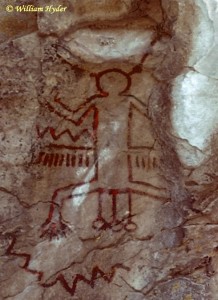 Figure 112. Rock painting from Carizo Plain,California, USA. Photograph © by William D. Hyder.
Figure 112. Rock painting from Carizo Plain,California, USA. Photograph © by William D. Hyder.
A large boulder in Petrified Forest, Arizona, USA, has several petroglyphs of anthropomorphic figures with both wings from the shoulders and wings from the hips (although they may also be viewed as bird petroglyphs with four wings, which – today – is equally biologically impossible). Rock paintings of four-winged creatures (birds?) also have been reported from El Diabolo, Cochabamba, Bolivia.
Most importantly, on rock cliffs in the Tapia Canyon in the Río Puerco area west of Albuquerque, New Mexico, USA, are at least two petroglyphs of fully frontally depicted anthropomorphs with distinct wing-elements from the hips (Figure 113). One of them has W-shaped arms and both have bolts of lightning emerging from the feet and the chest area. A very complex petroglyph of a fully frontally depicted anthropomorph with wings from the hip area is found at Crow Canyon, New Mexico. They all possibly represent anthropomorphised ‘thunder-bird’ images of Navajo manufacture (A.D. 1600 – 1750).
Figure 113. Petroglyphs from Tapia Canyon, New Mexico, USA. Drawing by Maarten van Hoek, based on photographs by Andrew and Alma.
All these examples prove undeniably that wing-elements may well emerge from any part of the body; also from the hips and thus Juan Chacama and Gustavo Espinosa may well be correct in their interpretation that the wing-elements of the Avian Staff Bearer truly represent the wings of a bird.
 The Avian ‘Avian Staff Bearer’
The Avian ‘Avian Staff Bearer’
However, there is more and even more convincing evidence that supports the hypothesis by Chacama and Espinosa. This graphical evidence has been presented in the ‘inventory’ of this study and some of it will be briefly reviewed here. Although indeed many depictions of the Avian Staff Bearer are in fact true anthropomorphic figures with only the wing-elements as possible avian components, there are several instances where the images are much more bird-like. Several of those images – especially images from important petroglyph sites in southern Peru – seem to have been unknown to some Chilean rock art researchers or have for some reason not been taken into account.
To start with, there seem to be two regions regarding the imagery of the Avian Staff Bearer in the Study Area. The first region, located west of the Andes, comprises a large part of the extremely dry desert, known as the Atacama. This very large region – housing the Sites 4 to 15 – is indicated with a predominant brown colour in Figure 2. The second, smaller region (including Sites 1 to 3) is found in the extreme SE part of the Study Area and comprises part of higher ground (much of it still part of the Atacama, though), which is indicated with a grey or grey-brown colour in Figure 2. The two regions are separated by a low mountain ridge west of the Upper Río Loa and the Río Coya (see map Figure 21).
The second region seems to have only true anthropomorphic representations of the Avian Staff Bearer and (many) related figures, but no avian Avian Staff Bearers; or in other words, no four-winged anthropomorphic (or avianthropic) figures. Although 125 millions of years ago some dinosaurs with four wings existed, bird-species with four wings do not exist at the moment.
Importantly, the first region clearly has a mixture of anthropomorphic Avian Staff Bearers and avian Avian Staff Bearers; Avian Staff Bearer with four wings. Most likely also all the four-winged creatures in Atacama rock art represent supernaturals. Examples of such four-winged creatures, some clearly Avian Staff Bearers, occur at Cahuisa, Duplijsa, Ariquilda, Suca (?), Calaunsa, Challatita and Toro Muerto. Thus far four-winged figures seem not to have been recorded at Tamentica, Cerro Chuño and Miculla. Especially the petroglyphs at Cahuisa, Duplijsa and Suca need to be discussed more fully.
Cahuisa-7: Although comprising only one petroglyph boulder, the imagery of Cahuisa-7 is most relevant in the scope of this discussion. The boulder bears three (probably rather large) petroglyphs of birds. At least, the central figure (B in Figure 114) and the figure to its left (C in Figure 114) most definitely depict birds. Judging by the enormous beaks and claws those two birds represent raptors – most likely condors – even though their wings are relatively (very) small. Their exaggeratedly fat bodies are very lightly pecked. The investigators correlate the imagery at Cahuisa-7 with nearby Tamentica (Ocampo 2007: 301), although a petroglyph of a large (140 cm!) and similarly ‘fat’ condor has also been recorded in the Alto Loa Valley, 130 km to the SSE (Gallardo et al. 2012: Fig. 8.D).
PDF-only – Figure 114. Petroglyphs from Cahuisa-7, Chile. Drawing by Maarten van Hoek, based on photographs in Ocampo 2007.
The two fat condors sharply contrast with the other ‘bird’ figure (A in Figure 114). Although it has a bird-head and wings emerging from the shoulders, there are some remarkable and controversial details. The wings look more like human arms that are held in the ‘surrendering’ position. Most significantly however, there is a second set of wings that emerges from the hip area. Even though those lower wings are similarly positioned as the ‘human’ arms of the upper set, I am certain that not a single rock art researcher will claim that this bird is ‘wearing a skirt’.
Especially this lower set of wings emphasises that this figure is not an ‘ordinary’ bird and moreover confirms that – in general – a wing emerging from the hip is a graphical possibility with no doubt a very specific cultural significance. Most likely it is a shaman transformed into a bird, or it represents the Spirit Helper of a shaman. The ‘unnatural’ character of this figure seems to be further emphasised by six forked lines that emerge from the four wings. Those lines probably represent the claws of the bird and also the presence of no less than six claws enhances the supernatural character of the image.
Interestingly, between the lowermost set of ‘claws’ is a long zigzagging line that is comparable with similar lines from typical (bird) petroglyphs at Tamentica (see Figures 27 and 28). Such lines in bird petroglyphs at Tamentica have been interpreted as the tail of the condor by Grete Mostny Glaser and Hans Niemeyer Fernández (1983: Figs 49 and 54). Also the rectangular shape of the outlined body of the Cahuisa Bird-A is more human-like and – together with the internal dots – it reminds us of the Avian Staff Bearer from Chusmiza (see Figure 39). Interestingly, below the four-winged figure is an isolated, short line with two ‘hooks’ that is similar to the objects carried by the Avian Staff Bearer at Chusmiza (see Figure 39).
Duplijsa: At Duplijsa much different types of four-winged figures occur besides more naturalistic petroglyphs of birds. Completely idiosyncratic is the four-winged avian Avian Staff Bearer image on Panel DUP2-001A (see Figure 31). It is exceptional as it seems to have intentionally been split into two, still connected halves (see Figure 32). The upper half seems to represent a bird; the lower part seems to be anthropomorphic, still featuring however, the typical wing-elements. As a result the whole figure is more avianthropic than anthropomorphic. On the opposite side of the same boulder, on Panel DUP2-001D, are two (perhaps three?) avian Avian Staff Bearers with bird-like feet. Importantly, one example even has four wing-elements that all emerge from the hip area (see Figure 33). Is this a figure wearing two skirts? I do not think so.
Chusmiza: Further north, at Chusmiza, is a petroglyph of an ornitomorphic figure with wings from the shoulder, but with a body that is similar to the body of the Avian Staff Bearer at Chusmiza-3. Juan Chacama already noted that in some cases the body decoration of Avian Staff Bearers at Ariquilda-1 is almost identical to the body decoration of bird petroglyphs at Ariquilda-1 (compare the images on Panels ARQn 085 and ARQs 032 that are only 500 m apart but are not intervisible). This fact at least underpins the theory that bird and anthropomorph imagery at this site (and several other sites) are strongly related. Also at Chusmiza is a petroglyph of a possibly four-winged ‘bird’ (?), which has been labelled as a linear geometric element however (Vilches and Cabello 2011: Fig. 3-C6).
Suca: Also at Suca-7 is a mixture of true Avian Staff Bearer petroglyphs and avianthropic petroglyphs. I already mentioned that the Avian Staff Bearer on Bloque 27 (see Figure 73) has a most idiosyncratic headgear. It seems to be a mixture of the radiant head and the wing-elements of the Avian Staff Bearer as the two horizontal appendages feature triangles that could well represent the feathers of the wings. The fact that those triangles point upwards is irrelevant in this respect (compare this with the upward pointing feathers of Petroglyph A at Cahuisa-7; see Figure 114). Triangles replacing digits (or feathers, for that matter) have been noticed in other petroglyphs (for instance at Ariquilda-1) and textiles (Pisagua and Chorillos).
All the examples described above – and also those described at Calaunsa, Challatita and Toro Muerto – of (four-winged) avian Avian Staff Bearers strengthen the hypothesis by Chacama and Espinosa that the Avian Staff Bearer is bird-related, even when wing-elements are the only avian properties of the figure.
 Explaining the Position of the Wing-Elements
Explaining the Position of the Wing-Elements
There may be another, more specific reason why the Avian Staff Bearer has its wing-elements emerging from the hip area. The line of reasoning involved here is based on (graphical) ergonomics and above all acknowledges that the choice of the place where the wings were added was very much intentional. First of all I strongly believe that at most rock art sites where the Avian Staff Bearer has been reported the practice of rock art production already existed since long. Rock art production in the Study Area certainly was not introduced by Tiwanaku (or Wari, for that matter). I also doubt that the graphical influence of Tiwanaku (or Wari, for that matter) was as influential as is always suggested. Moreover, it is not even certain that the Staff Bearer image was introduced to the Study Area from Tiwanaku.
But even if indeed it was Tiwanaku that influenced existing rock art traditions in the Atacama, it is certain that very specific figures evolved. Perhaps the most enigmatic combination is the Avian Staff Bearer, in which elements of old (bird-cult) and new (W-shaped arms holding ‘staffs’ and/or ‘trophy’ heads) traditions were combined. It moreover is rather well possible – and quite logical in view of Andean worldview – that in several rock art traditions human-bird conflations already existed prior to any purported Tiwanaku influence, or at least that a strong emphasis on bird imagery and bird symbolism existed at certain sites. In my opinion this latter option was especially the case at Ariquilda-1, where bird imagery is conspicuously present.
Therefore I would like to propose that possibly the Avian Staff Bearer represents a combination of existing local avian cults and a foreign Staff Bearer cult that possibly (!) was introduced from Tiwanaku (or from elsewhere). As the main characteristic elements of the Staff Bearer image are the downward pointing W-shaped arms (with sometimes symbolic ‘trophy’ heads attached), each holding a vertically arranged object (all elements consuming much space at the upper part of the figure), the manufacturer of the Avian Staff Bearer may have decided to place the wing-elements at the lower part – at the height of the hips – to allow the characteristic W-shaped arms plus paraphernalia to remain prominently included. In order to produce an aesthetically satisfactory combination, hip-elements seem to have been the best ergonomic solution in creating the new Avian Staff Bearer image. This solution also allowed for symmetry to be applied, as Andean aesthetics valued mirror-images of all kinds (Stone-Miller 1995: 16).
Another argument to accept that the wing-shaped elements from the hips of the Avian Staff Bearer indeed are bird-related (and thus obviously represent wings) is provided by for instance Tiwanaku and Wari iconographies. Importantly, in Tiwanaku (Figure 115) and Wari Staff Bearer imagery (Figure 116), especially the belt is also bird related, as evidently in several cases a raptor-head (condor?!) emerges from each side of the belt. This striking similarity between Conchopata (Wari) and Ponce (Tiwanaku) imagery raises the question whether Tiwanaku and Wari are not the same culture. Also an image on a ceramic from Pacheco, an ancient cemetery located 12 km west of Nasca in the Nasca Valley, Peru, shows similarly emerging bird-heads (Figure 117). This Pacheco figure is almost identical to a figure on another ceramic from Conchopata (Makowski 2001: Fig. 13b). So, if raptor-heads emerging from the hips are a fact in Andean iconography, why not accept the same concept for raptor-wings emerging from the hips?
PDF-only – Figure 115. Staff Bearer sculpture on the Ponce Monolith at Tiwanaku. Drawing by Maarten van Hoek, based on a drawing in Isbell 2008: Fig. 37.7.
PDF-only – Figure 116. Staff Bearer on a ceramic from Conchopata, Peru. Drawing by Maarten van Hoek based on a drawing in Isbell and Knobloch 2006: Fig. 12.5.
PDF-only – Figure 117. Staff Bearer on a ceramic from Pacheco. Peru. Drawing by Maarten van Hoek based on a drawing in Isbell 2008: Fig. 37.5.
The Messenger Avian Staff Bearer
In general wings often symbolise an intermediate position between heaven and earth. Wings are ambiguous symbols of communication between humanity and the divine. This is most evident in the wings emerging from the feet/sandals of the Greek messenger-god Hermes. If bird-wings from the feet area are acceptable; why not accepting bird-wings from the hips?
To determine the essence of the Avian Staff Bearer, it is necessary to review the Tiwanaku Staff Bearer in relation with other images in Andean iconography. The famous ‘Portal-God’ on the Sun Gate at Tiwanaku is said to possibly represent the Pan-Andean ‘Staff-God’ (also known as the Andean ‘Creator-God’ or Vira Cocha). The reason to hyphenate the term ‘Staff-God’ is that it is by no means certain that this figure (and many other Andean personages) actually represents an Andean Deity or God (and for that reason I prefer to use the term Staff Bearer in this study). Moreover, it has been argued that this figure holds a spear thrower (atlatl) and a staff (Stone-Miller 1995: Fig. 107), or spears and a spear-thrower (Stone-Miller 1995: 134; Wolf 2000; Reinhard 1988: 39), or two vertical staffs that terminate in condor heads (Moseley 2001: 220). It now proves that the distinction between staffs and spears and other objects is most relevant in the discussion of rock art images of the Staff Bearer.
In rock art (Avian) Staff Bearers often hold objects that are likewise ambiguous, especially as hardly any detail is shown. However, several rock art images, like the Avian Staff Bearer from Chusmiza-3 (Figure 118), may provide a clue. This Avian Staff Bearer holds a long vertical object in each hand. Those objects may symbolise spear-throwers as they clearly show hooks at both ends. These objects may be compared with one of the ‘staffs’ held by the larger anthropomorphic petroglyph on Panel HCR-S-006 at Huancor in central Peru (Figure 119). On this panel are two frontally depicted anthropomorphs. Both figures – though small and weathered – have parallel, curved lines emanating from their heads and both figures hold a vertical, linear object in each hand. The larger figure however has an object in its right hand that clearly shows hooks, while the object in the other hand seems to show feathers at the lower end. Therefore the Chusmiza-3 and the Huancor figures may represent ‘warriors’ in the Staff Bearer position, holding a spear-thrower and spear as if they are ‘staffs’.
Figure 118. Avian Staff Bearer at Chusmiza-3, Chile. Drawing by Maarten van Hoek, based on a photograph by Gustavo Moscoso.
Figure 119. Petroglyphs of possible Staff Bearers on Panel HCR-S-006 at Huancor, Peru. Drawing © by Maarten van Hoek.
In his book about the Nazca Lines Johan Reinhard (1988: Fig. 35) includes a drawing of a Paracas textile (dating from around 200 B.C.) that clearly shows a Staff Bearer with the characteristic (Cerro Unitas) radiant head and the W-shaped arms. Interestingly, from the hip area three lines emerge from each side: skirt or wings? The ‘staffs’ however include one straight object (apparently the spear-thrower) held in one hand and two spears or darts held in the other hand. Therefore it is certain that – at least in this figure – the objects are no staffs.
Convincing evidence that also in Andean rock art spear-throwers have been depicted is found on Panel CHY-F-004 at Chillihuay. One large anthropomorph on this vertical panel clearly has a spear thrower plus ‘spear’ in one hand and another ‘spear’ (looking like an arrow, though) in the other. The other, fully frontally depicted anthropomorph on the same panel clearly exhibits the Staff Bearer position and his W-shaped, outstretched arms have hands (with three digits each) that hold (rather, touch) two ‘spears’ and a ladder-shaped device that probably represents the actual atlatl (Figure 120). This evidence may imply that the Staff Bearer has evolved into a (divine?) ‘Warrior’, or simply (perhaps later still) into an earthly warrior.
PDF-only – Figure 120. Petroglyph of a possible Staff Bearer on Panel CHY-F-004 at Chillihuay, Peru. Drawing © by Maarten van Hoek.
However, I have argued earlier (Van Hoek 2011a: 173, Fig. 155) that the Staff Bearer often shows characteristics of the Decapitator (thus presenting a conflation), and also that the Staff Bearer (Figure 121A) is interchangeable with the ‘Decapitator’ (Figure 121B); another important Andean figure often carrying ‘trophy’ heads. As several Tiwanaku (Staff Bearer) figures are said to show ‘trophy’ heads, two often attached from the nadir of the W-shaped arms, also Tiwanaku figures may combine the essence of the Staff Bearer and of the ‘Decapitator’. In this respect it may be important that a Paracas textile from southern Peru shows a figure in the Staff Bearer position holding two ‘spears’ in the left hand. However, in the right hand it holds a ‘trophy’ head that seems to be the lower part of a staff-like object. Another Paracas textile bears a fully frontally depicted anthropomorph holding a ‘trophy’ head in the right hand and a segmented, straight object in the left hand. This segmented object is comparable with the ladder-designs in panel CHY-F-004 at Chillihuay.
PDF-only – Figure 121. A: Part of the ‘Raimondi Deity’ sculpture at Chavín de Huántar. Drawing by Maarten van Hoek, based on Fig. 176 in: Burger 1995. B: Ceramic bottle; provenance unknown, but probably from northern Peru. Drawing by Maarten van Hoek, based on photographs of the Museo Chileno de Arte Precolombino in Santiago de Chile. Código de pieza: MChAP-3096.
All those images may indicate that the ‘Staff Bearer’ and the ‘Decapitator’ and the ‘Warrior’ (whether representing a divine or secular personage) once represented one and the same deity/person. Also several rock art images of the Avian Staff Bearer seem to combine elements of the Staff Bearer (‘staffs’ and/or W-shaped arms) and the ‘Decapitator’ (‘trophy’ heads) and the ‘Warrior’ (‘spear-throwers’). But why was it so essential to also include wing-elements in the figure of the Avian Staff Bearer? In this study I claim that new elements (‘staffs’, ‘trophy-heads’, W-shaped arms and the frontal position) were combined with an already existing bird-related cult that was based on the function of the bird as a divine messenger. Thus the figure of the Staff Bearer merged with bird imagery and this resulted in a Messenger Avian Staff Bearer. Therefore the bird-wings emerging from the hips became essential in this new figure. The staff-elements on the other hand became less important and were often omitted (as were the ‘trophy’ head elements). Those elements may even have lost their original meaning. It may even be argued that the four-winged images further emphasised the symbolism of the bird as messenger to the Andean deities.
Indeed, in Andean worldview specific bird species are often mediators between the Supernatural Realm and the people and vice versa. This concept is expressed as follows (Clarkson and Morales 2014): ‘Los humanos que sirven como agentes de los dioses son los shamanes y curanderos, quienes reciben asistencia de las deidades en forma de aves’. This messenger-function most likely was the essence of the many ancient bird-related cults in the Study Area and beyond. This idea is not a new concept. It has already been formulated by Juan Chacama (2000: 22, citing Tristan Platt [1997: 55]) : ‘La tarea del Yachaj (chaman) a lo largo de las sesiones consiste en facilitar a la congregación comunicarse con el Jurq´u (cóndor), mientras que, por su parte, la del jurq´u es facilitar un puente entre la congregación y el Tata Pumpuri (cerro malku)’. Therefore, in order to graphically formulate the concept of the Messenger Avian Staff Bearer, it was essential for the established cultures in the Study Area to especially incorporate the wings into the newly introduced Staff Bearer imagery. And the graphically best suitable place to add the wings was the hip area.
Despite the fact that the Avian Staff Bearer often bears ‘weapons’ and often carries stylised ‘trophy’ heads, the figure cannot be regarded as merely a Staff Bearer (‘God’) or a Warrior (‘God’) any longer! In my opinion the Avian Staff Bearer is a Sacred Messenger. This idea confirms the hypothesis put forward earlier by Juan Chacama (2000) that the Avian Staff Bearer is shaman-related and served as a Sacred Mediator.
But which bird species is indicated with the wing-elements of the Avian Staff Bearer? Juan Chacama tentatively speaks of ‘hombres-falcónidas’ (falcónida = raptor) and ‘hombres-pájaros’ (pájaro = bird), and he emphasises that ‘falcónida’ refers to birds-of-prey in general (2000: 9; my addition between [ ]): ‘Más allá de la representación genérica nos parece imposible por ahora identificar [at Ariquilda-1] especificidades como Halcones, Cóndores, Águilas u otro tipo de Falcónida…’. For that reason the inventory by Juan Chacama (2000: 9) does not specifically mention the occurrence of condor petroglyphs at Ariquilda-1, but yet he as well confirms the importance of the condor as a sacred Messenger Bird. I do not reject this generic categorisation, but I strongly advocate that possibly the bird-properties of the Messenger Avian Staff Bearer are indeed condor-related, especially at Ariquilda-1 (see video).
Indeed, the condor is generally accepted to represent the most authoritative Messenger Bird in Andean worldview. The condor was and still is a most important bird in Andean worldview. The condor-ritual of Yawar Fiesta is still practiced in some regions of the Andes and although Núñez Jiménez (1986) often refers to combinations of raptors sitting on zoomorphs as Yawar Fiesta, those petroglyphs probably have nothing to do with this Post Colonial ritual. Those Pre-Columbian rock art images do however enhance the importance of the condor. For instance, some rock art images at Alero la Gruta, Argentina, are said to depict offerings made by humans to condors (Martel 2009: Figs 2 and 4). Also mummies of condors have been found in rock shelters in the Andes.
Although several Chilean rock art researchers speak of a ‘hombre-cóndor’, referring to certain bird-human conflations in rock art (for example Aguayo Sepúlveda 2008: Fig. 10), they do not refer to the Avian Staff Bearer described in this study. Neither does Chacama for reasons explained above. Yet in this study I would like to propose that the Avian Staff Bearer may well represent the condor. This may especially be true for the impressive rock art site of Arequilda-1, where I spotted condors circling the skies and at a certain moment a young condor even landed on the decorated cliffs at Ariquilda-1 (see video).
Therefore, the site of Ariquilda-1, with its many high-flying petroglyphs of raptors (condors?!), may well be regarded as a ‘Kuntur Wasi’, meaning the ‘House of the Condor’ in Quechua (kuntur = condor, wasi = house). However, whatever bird-species is depicted at Ariquilda-1, it is beyond any doubt that this site was and still is a sacred place where communication between the ancient Atacameños and their Ancestors and Deities took place. Importantly, those Deities and the Ancestral Spirits are generally accepted to reside on the tops of sacred mountains, often called Apus. In this respect Aguayo Sepúlveda characterises the condor as follows: ‘la fuerza y el espíritu de la montaña’ (2008: 77). Another possibility is that the condor is a messenger-bird for Inti, the Inca ‘Sun-God’. Acknowledging this, it is remarkable that at Ariquilda-1 many solar figures have been manufactured, some very near an image of the Avian Staff Bearer (see video), some of which also have a radiant head (a solar element?!).
In combination with the fact that the condor can be spotted at Ariquilda-1 and that most likely the condor is depicted there, it is vital that from Ariquilda-1 the sacred mountain (Apu) of Tata Jachura, a 5340 m high volcano, 40 km to the east of Ariquilda-1 (Figure 122), is clearly visible from certain points in the gorge (Figure 123). The often snow-capped volcano is also clearly visible from Pintanane; a spot only 9 km upstream from Ariquilda-1 in the Quebrada de Aroma where (unfortunately?) the construction of a huge dam and reservoir is scheduled. Hopefully the activities and the resulting dam will not affect the important rock art site of Ariquilda-1.
PDF-only – Figure 122. Aerial view of Ariquilda-1 and the Apu Tata Jachura, looking east. Drawing by Maarten van Hoek, based on Google Earth.
Figure 123. View of the Apu Tata Jachura from Ariquilda-1, looking east. Photograph and drawing (rotated detail of Panel ARQs-037) © by Maarten van Hoek.
PART III
The Journey of the Avian Staff Bearer
In this study I demonstrated that images of the Avian Staff Bearer occur in an area larger than previously accepted, as – until now – only examples from Chile were considered. However, of mayor importance are three rock art sites in the south of Peru where the Avian Staff Bearer also occurs. This proves that modern boundaries are completely irrelevant when it comes to rock art studies, making it essential for rock art researchers to look outside their national box.
Based on this study the distance between the southernmost known site with an image of the Avian Staff Bearer or related figure (Vilama Sur in Chile) and the northernmost site (Toro Muerto in Peru) is no less than 930 km. Rock art images of Staff Bearers are even more widespread, as they occur (rarely, though) in northern Peru as well.
Despite its enormous geographical distribution and taking into account its importance, the image of the Avian Staff Bearer is surprisingly rare in absolute terms. Only 26 examples of true Avian Staff Bearer images (Types 1A and 1B) have been reviewed in this study (bearing in mind that these are only minimum numbers). Another remarkable aspect of its geographical distribution is that the image is found more horizontally than vertically. This means that images of the Avian Staff Bearer mainly seem to emerge on the main north-south running caravan route across the Atacama, thus parallel to the coast. Vertically arranged distribution of the Avian Staff Bearer (on routes from [near] the coast to the Altiplano) is more uncertain, but seems to occur in the Calama – San Pedro group and (less obvious) at Miculla-Challatita.
Only the Loa-Salado drainage in Chile and the Caplina drainage in Peru have two (possibly more) rock art sites with images of the Avian Staff Bearer. This mainly horizontal distribution may have implications for the possible migration patterns of the Avian Staff Bearer.
In all other cases the Avian Staff Bearer has (so far) been reported at only one rock art site in all other drainages (Vilama, Huatacondo, Cahuisa, Parca, Tarapacá, Aroma, Suca, Codpa, Azapa and Majes). Moreover, in most cases there are only one or just a few images of the Avian Staff Bearer at each site. Only at Ariquilda and Miculla-Challatita there are relatively many petroglyphs of the Avian Staff Bearer and only in the area around Calama-San Pedro – especially in the Loa drainage – are many sites with images of Staff Bearers and a few Avian Staff Bearers.
Yet, the existence of only one rock art site with Avian Staff Bearer(s) does not exclude vertical distribution, as is argued for the single rock art site of Cahuisa-7 (Ocampo 2007: 301-302). This seems also to be the case at Tamentica where a ‘vertically’ arranged line of archaeological sites clearly marks the route from the coast via Tamentica and Tolar to the Altiplano and then further south through the Loa valley (see Figure 21). At Tamentica this vertical route clearly crosses a major horizontal route across the Atacama that is marked with geoglyph sites.
The big puzzle is now to trace the origin and the possible journey of the Avian Staff Bearer. There are two general possibilities. The image of the Avian Staff Bearer originated independently at each site mentioned in this study. Then we speak of parallel evolution. Having studied Andean iconography for several years – an area with a high degree of graphical and ideological diffusion – I regard this possibility to be highly unlikely.
Alternatively, the image originated in one (or more) area(s) and then diffused to other sites. The problem is now that both diffusion and parallel evolution may have taken place. It is also possible that diffusion took place not from one, but from several directions. Thus the migrations of the Avian Staff Bearer may be very complex and it is uncertain if the true migration-patterns will ever be unravelled. Therefore, in this study I prefer to put forward possibilities and uncertainties regarding the journey of the Avian Staff Bearer, without offering solutions.
Several Chilean researchers seem to accept that the archetype of the Staff Bearer – and thus also the Avian Staff Bearer – was introduced from Tiwanaku. In this respect it is customary to especially point to the image on the ‘Gateway of the Sun’ at Tiwanaku when it comes to pinpointing the origin of the Staff Bearer in the Atacama, while the equally important Ponce Monolith is hardly ever referred to. For instance, Juan Chacama (2000: Fig. 13) directly associates the biggest Avian Staff Bearer petroglyph from Ariquilda-1 with the image on the ‘Gateway of the Sun’ at Tiwanaku (see also Chacama and Espinosa 1997: Fig. 12). Chilean researchers moreover frequently discuss or refer to the many Tiwanaku ‘related’ images on several objects (mainly wooden snuff-tablets) found near San Pedro de Atacama. For instance, Macarena Lopez compares the image on the ‘Gateway of the Sun’ with images found on several snuff tablets found around San Pedro de Atacama (2007: Chapter 1: Figs 16 and 17), and she duplicates (2007: Chapter 2: Fig. 7) the illustration previously published by Chacama.
Based on those assumptions the image travelled – according to several Chilean archaeologists – from the Lago Titicaca area across the Altiplano to the (area around San Pedro de) Atacama Desert. In their paper ‘La Ruta de Tarapacá’, Juan Chacama and Gustavo Espinosa include a map (1997: Fig. 13) that seems to suggest that the image of the Staff Bearer travelled south from Cusco in Peru via Lago Titicaca and Lago Poopó and that from that main route the image migrated west using several ‘minor’ routes (and thus emerged in the rock art of several sites in the Atacama Desert?). They moreover suggest a Pucara (older) or a Tiwanaku (later) origin for the Staff Bearer images in the Atacama. However, there are several problems with this migration-model and for that reason this study does not accept Tiwanaku as the source of the Avian Staff Bearer and consequently has not been included into the Study Area.
The main problem of this migration-model was raised by William Isbell and Patricia Knobloch (2006: 316-317) who argue that many of the wooden objects from the San Pedro area – with purported Tiwanaku Style decoration – are much older than Tiwanaku, pointing for instance to examples from Cemetery-8 at Quitor, which were dated 300 B.C to A.D. 200, while Tiwanaku IV – the period of the typical Tiwanaku-Style sculpture – did not emerge earlier than A.D. 500 or even A.D. 600. Therefore they claim that the term ‘Tiwanaku-Style’ is probably not an appropriate name. Interestingly, they moreover wrote that – possibly – the wooden snuff tablets were an early vehicle for Tiwanaku-Style icons spreading throughout the southern Andes. They added that this possibility is an important, but complex, issue for further study. They however do not explicitly state that the San Pedro area was the cradle of the Staff Bearer. Although they offer most plausible and trustworthy information, the biggest problem that I have with archaeological studies like this, is that the rich source of (fixed!) rock art images is completely ignored. Also Isbell and Knobloch (2006) do not refer to any rock art image in their essay. And yet there are some remarkable conclusions regarding the relation between rock art images and major temple complexes in the Andes.
So, is it indeed possible that the Tiwanaku-Style Staff Bearer initially originated in the nucleus between San Pedro de Atacama and Calama? If this is the case, this raises other problems. Was the Atacama Staff Bearer (thus not the Tiwanaku-Style Staff Bearer) introduced to the area, and if so, from where and when and via which route? Moreover, which image originated first: the Avian Staff Bearer or the ‘Staff Bearer’? Is it possible that from the San Pedro nucleus the Staff Bearer travelled north across the Altiplano towards Tiwanaku and that (simultaneously?) the Avian Staff Bearer migrated NNW (via Loa and Huatacondo) towards the Atacama?
The route towards Tiwanaku (or vice versa?) may have used the Loa Valley and the Vilama Valley; the latter connecting the San Pedro-Calama nucleus with the Altiplano area of Lípez. The Vilama Valley is, according to Gonzales Pimentel (2008), one of the oldest caravanning routes from the Atacama to the Altiplano. Remarkably, Pimentel does not mention the specific Avian Staff Bearer petroglyph that is said to have been recorded in this valley.
From the San Pedro-Calama nucleus another important route first ran due north following the Loa Valley and then turned sharply west, possibly near Ujina where a geoglyph has been reported (Briones et al.: 2005: Fig. 2). An illegible and thus scientifically useless map of this route has been published by Cabello et al. (2013: Fig. 1). Via Ujina-Collahuasi-Tolar (Cabello and Gallardo 2014: 18) it connected the Upper Loa Valley with the Huatacondo Valley, where the Avian Staff Bearer surfaced at Tamentica-1 (together with an enormous concentration of geoglyphs just SW and NW of Tamentica). Portable objects, like the gold artefact from Huatacondo or the textile from Pisagua, both depicting the Avian Staff Bearer (see Figures 29 and 69), may have served as vehicles of the vertical diffusion.
I already argued that this vertical distribution – involving coast-highland routes – is quite obvious in the Huatacondo Valley (see Figure 21). Ruins of prehistoric settlements (Ramaditas and Huatacondo), geoglyphs and several rock art sites are found well inside this valley. The horizontal distribution in this area – involving a major north-south route through the Atacama – is indicated by several geoglyph sites and, at Tamentica, only three rock art sites very close together. The rock art site of Cahuisa-7 is an isolated site that is not found in a valley and, moreover, is located about 20 kilometres east of the major north-south caravan route (see Figure 21). Yet, it has been argued that Cahuisa-7 is located at or near a (minor?) horizontal route (Ocampo 2007: 301-302).
From Tamentica the figure may have travelled north (via Cahuisa? and Duplijsa?) towards another important nucleus; the area around Ariquilda. Alternatively, the Avian Staff Bearer may have originated at Ariquilda-1 – completely independent from Tiwanaku influence – and may have travelled north via Suca to the Miculla-Challatita complex in southern Peru and SSE via Cahuisa, Duplijsa and Tamentica to the Upper Loa Valley and beyond.
However, there are other possibilities. The Staff Bearer may have travelled from the Lago Titicaca region to the Miculla-Challatita complex and from there may have spread north to emerge in rock art sites in Arequipa (Toro Muerto) and Ica (Río Grande and Huancor) and to the south to surface at sites in the extreme north of Chile (Cerro Chuño and Calaunsa) and beyond.
Importantly however, the oldest representation of the Staff Bearer was found in ‘Cemetery-P’ in the Pativilca Valley in 2002 (Figure 124). C14 Radio Carbon dating of this fragment of a pyro-engraved gourd showed that it dates from around 2250 B.C., thus predating the Chavín ‘culture’ by more than a thousand years. Also the very ancient temple at Sechín Bajo in the Sechín Valley features images of the Staff Bearer (Figure 125). Therefore, the concept of the Staff Bearer most likely originated somewhere on the coast of what is now northern Peru and the concept of the Staff Bearer is definitely not a Chavín invention. Chavín only borrowed the image of the Staff Bearer from earlier coastal MSC-cultures (Manchay, Sechín and Cupisnique).
PDF-only – Figure 124. Image of a Staff Bearer engraved on a gourd fragment found at ‘Cemetery P’ in the Pativilca Valley, Peru. Drawing by Maarten van Hoek, based on a drawing by Jill Seagard of the Field Museum, Chicago.
PDF-only – Figure 125. Image of a Staff Bearer, part of a clay frieze at the temple complex of Sechín Bajo, Sechín Valley, Peru. Drawing by Maarten van Hoek, based on a drawing in Patzschke 2008: Abb 50.
Earlier I demonstrated that the image of the Staff Bearer is relatively very rare in Andean rock art (Van Hoek 2011a). Moreover, images of the Staff Bearer also appear at rock art sites in southern Peru, like in the valleys of the San Juan at Huancor (see Figure 119), Rio Grande (both in Ica) and Ocoña (in Arequipa). The last example – recorded at Chillihuay in Arequipa – clearly represents a warrior (see Figure 120). It is held by me to be a local variation of the Staff Bearer that was strongly influenced by Paracas imagery of warriors (Van Hoek 2015). So, it is even possible that the image of the Warrior Staff Bearer travelled south along the coast via Arequipa to finally reach the Miculla-Challatita complex, where – possibly – it turned into the figure of the Avian Staff Bearer, which in turn travelled further south (or even to Tiwanaku?).
It clearly proves that the potential migration patterns of the (Avian) Staff Bearer are most complex and uncertain. There are simply too many possibilities. Moreover, the concept of the Staff Bearer is very old and was used in many Andean cultures from possibly 2500 B.C. to A.D. 1572; a time span of almost 4000 years. An extra problem in this respect is the difficulty (or rather, the impossibility?) to absolutely date all the known rock art images of the (Avian) Staff Bearer. Moreover, in this study both statistics and distribution of Avian Staff Bearer images are subject to taphonomic logic. One can only consider the data that are available.
Accepting the limitations determined by taphonomic logic, it still proves that, regarding the distribution of the (Avian) Staff Bearer in Andean rock art, a general but remarkable pattern emerges. Rock art images of the (Avian) Staff Bearer have their distribution west of the Andes and west of the Altiplano, while, except for the (much) earlier coastal MSC-cultures (Manchay-Sechín-Cupisnique), most of the major temple complexes and administrative centres of the major Andean cultures are found high up in the mountainous highlands and Altiplano of the Andes. In my opinion this strengthens my theory that High Andes cultures have borrowed the image of the Staff Bearer from coastal cultures (and after that from each other).
It is therefore no surprise that all rock art images of the Avian Staff Bearers are very remote from Tiwanaku, which is most evident in Figure 2. Only the Miculla-Challatita complex is located relatively ‘near’ Tiwanaku (about 210 km SW of Tiwanaku). Moreover, as far as I know, only one rock art site has been recorded very near Tiwanaku. It concerns the petroglyph site of Hak’e Kayu, fully described by Juan Albarracín-Jordán (1991). But definitely no petroglyphs or rock paintings of the Avian Staff Bearer occur at that site, in the Tiwanaku region or anywhere else in the Altiplano south of Tiwanaku (while yet several rock art sites have been recorded in that large area).
Interestingly, the same pattern is repeated at two other important cultural centres further NW from Tiwanaku: Huari in highland central Peru and Chavín (de Huántar) in highland northern Peru. To my knowledge there are only (very) few rock art sites in the immediate neighbourhood of Huari and no recordings of the Staff Bearer. Also in purported ‘Wari’ rock art in ‘conquered’ areas (Nasca, Majes) no Wari-Style Staff Bearer images have so far been recorded. The few rock art images of the Staff Bearer in those areas are in my opinion much older than Wari. The alleged ‘Wari’ rock art west of the Andes (for instance in Ica and Arequipa) is of local (Paracas, Nasca and Majes) origin and is only extremely minimally influenced by Wari iconography (Van Hoek 2013a: 87-90). In fact I seriously doubt if there is anything like a specific Wari (or Chavín or Tiwanaku) rock art tradition.
Indeed, the same goes for Chavín de Huántar. Very few (and only simple) rock art sites occur in the same valley and again there is no record of any Staff Bearer in the local rock art, which would be anticipated. The rock art traditions that do include images of Staff Bearer and related figures are found much further west of Chavín de Huántar, across two high mountain ranges, and belong to the much earlier, coastal MSC-Style, as they definitely have a Manchay, Sechín and Cupisnique origin. It is thus more likely that the Staff Bearer image was borrowed by Chavín from the earlier Manchay, Sechín and Cupisnique cultures and ultimately transferred from Chavín to other civilisations, like Wari-Tiwanaku. But again, the image of the Staff Bearer may well have travelled independently south along the coast (later, at the same time or even – and more likely – earlier than Chavín).
It was Johan Reinhard who, as early as 1983, first noticed the correlation between the gigantic geoglyph at Cerro Unitas (see Figure 35) and the petroglyph of the Avian Staff Bearer on Panel ARQn-085 at Ariquilda-1 (see Figure 46). Much later Juan Chacama (1995-2005), afterwards together with Gustavo Espinosa (1997), convincingly argued that the elements from the hips of several (Atacama rock art) anthropomorphs in fact represented the wings of a raptor. Remarkably, their perspective was not really accepted by several archaeologists, who preferred to interpret the elements from the hip as ‘skirts’.
For several reasons this study rejects the ‘skirt’ interpretation and re-establishes the raptor-related perspective first advocated by Chacama and Espinosa. The rationales for this re-evaluation are mainly based on graphical evidence from the Chilean Atacama, but also – for the first time, though – on evidence from the Peruvian Atacama Desert, where especially the imagery of the petroglyph site of Challatita offered convincing proof.
Firstly, this study convincingly demonstrated that wing-elements emerging from the hip area of anthropomorphic figures must be accepted as a graphical and cultural reality. There is nothing illogical in wing-elements attached to the hips. I also argued that the position of those wing-elements was ergonomically determined. It simply is an acceptable and logical position if the specific elements of the (introduced!) Staff Bearer (W-shaped arms holding staffs and carrying ‘trophy’ heads) were to be included as well. I also strongly advocate that it was the Staff Bearer figure (not the concept as such) that was introduced to the Study Area and that it was combined with an already existing bird-related cult, in which the bird fulfilled the role of Divine Messenger. The resulting Avian Staff Bearer continued to perform the role as Messenger. ‘Staffs’ and ‘trophy’ heads became subordinate to the W-shaped arms and – especially – the wings. That the wings – in fact the bird properties – became more important is not only demonstrated by examples of Avian Staff Bearers with only wings, but also by images with four wings; the avian Avian Staff Bearer. What is also important is that most Avian Staff Bearers still retained their Radiant Head, most likely as a solar symbol. Furthermore, in my opinion it is highly likely that the bird-properties of the Avian Staff Bearer are condor-related.
From this study it also seems that many key aspects of the Andean past have been subject to ‘factoidal’ interpretations. Factoidal interpretations, or factoids, are those unsubstantiated ideas that are repeated over a significant amount of time to the point where they become more convincing than the actual facts (Viau-Courville 2014: 24, my emphasis in italics). Mathieu Viau-Courville continues to say that ‘Staff Gods, as argued here, are probably one of the most enduring factoids in Andean studies. The idea the figures may all be representations of gods or that the central personage of the Gateway of the Sun may be a high ruling god are both factoids’. Is it possible that in fact the generally accepted Tiwanaku-Atacama connection regarding the Avian Staff Bearer is also a factoid?
Acknowledgements
I especially thank Rolando Ajata for his support for many years, and for sending me several of his photos of the petroglyphs of Suca (Figures 71, 72, 74 and 76), as well as a photograph of the archaeological site of Chusmiza (Figure 39). I also express my thanks to Johan Reinhard who has sent me many photographs of Ariquilda-1 (Figures 34, 54, 60 and 66). Also I mention the kindness of Francisca Fernandez, who has sent me a copy of her publication about the Conanoxa petroglyphs. I also thank Adrián Oyaneder who has sent me several pictures of the petroglyphs at Conanoxa (Figure 77). I also would like to thank the courtesy of de following persons who sent me several photographs of various rock art sites: Rainer Hostnig (Figure 85 of Miculla), Coen Wubbels (Figures 50 and 52 of Ariquilda-1), Billy Morales of Chileresponsibleadventure.com (Figures 57A and 57B of Ariquilda-1), Dinko Kosanovic (Figure 67 of Ariquilda-1) and William D. Hyder (Figure 112 of Carizo Plain). Finally, I would like to thank all people who, directly or indirectly, helped me with the realisation of this project, especially my wife Elles.
Agradecimientos
Agradezco en forma especial a Rolando Ajata por el apoyo brindado durante muchos años, quien me hizo llegar fotografías de los petroglifos de Suca (Figuras 71, 72, 74 y 76) y una foto del sitio arqueológico de Chusmiza (Figura 39). También expreso mis agradecimientos a Johan Reinhard que me ha facilitado fotografías de Ariquilda-1 (Figuras 34, 54, 60 y 66). Menciono además la gentileza de Francisca Fernández, quien me envió una copia de una publicación suya sobre los petroglifos de Conanoxa. Asimismo, agradezco a Adrián Oyaneder por proporcionarme fotografías de los petroglifos de Conanoxa (Figura 77). También quisiera agraceder la gentileza de las siguientes personas quienes me enviaron fotografías de varios sitios rupestres: Rainer Hostnig (Figura 85 de Miculla), Coen Wubbels (Figuras 50 y 52 de Ariquilda-1), Billy Morales de Chileresponsibleadventure.com (Figures 57A and 57B de Ariquilda-1), Dinko Kosanovic (Figura 67 de Ariquilda-1) y William D. Hyder (Figura 112 de Carizo Plain). Finalmente, quiero agradecer a todas las personas que directa o indirectamente me ayudaron de alguna forma en la elaboración de este trabajo, especialmente a mi esposa Elles.
I would like to emphasise that only I am responsible for all the (information in the) illustrations, hypotheses, observations and conclusions presented in this paper.
Please be aware that any URL included in this paper (functional as per January 2016) may be broken or even hacked. Please notify me if any broken link occurs.
References
Aguayo Sepúlveda, E. E. 2008. Símbolos y Sacralidad en el Arte Rupestre de la Provincia del Loa: del siglo X al XXI. Memoria para optar al título de Arqueólogo. Universidad de Chile.
Albarracín-Jordán, J. 1991. Petroglifos en el valle bajo de Tiwanaku, Depto. de La Paz, Bolivia. Boletín de SIARB. Vol. 5; pp. 35 – 56. La Paz, Bolivia.
Berenguer, J. R. 1999. The vanishing language of rock art in the Andes of Atacama. In: Rock art in the Andes of Capricorn. Museo Chileno de Arte Precolombino. Santiago de Chile, Chile.
Brant, E. 2008. New Petroglyph Findings from Northern Chile: A Study of Dating and Function. California State University, Northridge, California, USA. Available on-line as PDF.
Briones Morales, L. and J. Chacama Rodriguez. 1987. Arte rupestre de Ariquilda: Análisis descriptivo de un sitio con geoglifos y su vinculación con la prehistoria regional. Chungará. Revista de Antropología Chilena. Vol. 18; pp. 15 – 66. Arica, Chile.
Briones, L., L. Núñez and V. G. Standen. 2005. Geoglifos y tráfico prehispánico de llamas en el Desierto de Atacama (norte de Chile). Chungara. Revista de Antropología Chilena (Reportes Monográficos). Vol. 37, Nº 2; pp. 195 – 223. Arica, Chile.
Burger, R. L. 1995. Chavín and the origins of Andean civilization. Thames and Hudson, London.
Cabello, G. and F. Gallardo. 2014. Iconos claves del Formativo en Tarapacá (Chile). El arte rupestre de Tamentica y su distribución regional. Chungara. Revista de Antropología Chilena. Vol. 46-1; pp. 11 – 24. Arica, Chile.
Cabello, G., F. Gallardo and C. Odone. 2013. Las pinturas costeras de Chomache y su contexto económico-social (Región de Tarapacá, norte de Chile). Boletín del Museo Chileno de Arte Precolombino. Vol. 18-1; pp. 49 – 66. Santiago de Chile.
Cases, B. and I. Montt. 2013. Las túnicas rupestres pintadas de la Cuenca Media y Alta del Loa desde Quillagua (norte de Chile). Chungará. Revista de Antropología Chilena. Vol. 45-2; pp. 249 – 275. Arica, Chile.
Chacama, J. MS dated 1995. Personaje irradiado, figura tipo del sitio Ariquilda-1. Análisis tipológico de figuras antropomorfas. Ponencia presentada en el Simposio Internacional de Arte Rupestre Andino. Universidad de Tarapacá. Arica, Chile.
Chacama, J. MS dated 2000. Hombres, Pájaros y Hombres-Pájaros. Análasis iconografíco de figuras humanas y aves grabadas sobre roca. Quebrada de Aroma, Sitio Ariquilda-1, extremo norte de Chile. 2004: Ponencia presentada en el 51 Congreso Internacional de Americanistas, Santiago. 2004: In: Simbolismo y ritual en los Andes septentrionales. Chapter 8; pp. 165-187. Editora Mercedes Guinea. Quito, Ecuador.
Chacama, J. and G. Espinosa. 1997. La ruta de Tarapacá: análisis de un mito y una imagen en el norte de Chile. Actas del XIV Congreso Nacional de Arqueología Chilena. Tomo 1; pp. 769 – 792. Museo Regional de Atacama, Copiapó, Chile.
Chacama, J. and G. Espinosa. 2005. La Ruta de Tarapacá: análisis de un mito y una imagen rupestre en el Norte de Chile. In: Rupestreweb.
Clarkson, P. B. and L. Briones Morales. 2014. Astronomía cultural de los geoglifos Andinos: un ensayo sobre los antiguos Tarapaqueños, norte de Chile. Diálogo Andino. Vol. 44; pp. 41 – 55.
Espinosa, G. 1996. Lari y Jamp’atu. Ritual de luvia y simbolismo andino en un escena de arte rupestre e Ariquilda-1. Norte de Chile. Chungará. Revista de Antropología Chilena. Vol. 28 – No’s. 1-2; pp. 133 – 157. Arica, Chile.
Faron-Bartels, R. 2008. El ornamento-símbolo, su elaboración y significado. El análisis de la ornamentación de las lajas pintadas de Pampacolca, departamento de Arequipa. In: Rupestreweb.
Faron-Bartels, R. 2011a. Piedras votivas de Pampacolca. Nuevos datos sobre las lajas pintadas del sur del Perú. Inauguraldissertation zur Erlangung des Grades eines Doktors der Philosophie am Fachbereich Geschichts- und Kulturwissenschaften der Freien Universität Berlin. Berlin.
Faron-Bartels, R. 2011b. Piedras votivas de Pampacolca. Nuevos datos sobre las lajas pintadas del sur del Perú. Anexo. Inauguraldissertation zur Erlangung des Grades eines Doktors der Philosophie am Fachbereich Geschichts- und Kulturwissenschaften der Freien Universität Berlin. Berlin.
Fernández Donoso, M. F. 2013. Caracterización del Arte Rupestre de las Terrazas de Conanoxa, Valle de Camarones, extremo norte de Chile, Andes Centro Sur. Práctica profesional. Universidad de Chile. Santiago de Chile.
Gallardo, F., C. Sinclaire and C. Silva. 1999. Arte Rupestre, emplazamiento y paisaje en la cordillera del Desierto de Atacama. In: Arte Rupestre en Los Andes de Capricornio. Part II; pp.: 57 – 96. Eds. J. Berenguer and F. Gallardo. Museo Chileno de Arte Precolombino. Santiago.
Gallardo, F., G. Cabello, G. Pimentel, M. Sepúlveda and L. Cornejo. 2012. Flujos de información visual, interacción social y pinturas rupestres en el desierto de Atacama (norte de Chile). Arqueología y Antropología Surandinas. Estudios Atacameños. Vol. 43; pp. 35 – 52. San Pedro de Atacama, Chile.
Horta, H. 2004. Iconografía del Formativo Tardío del norte de Chile. Propuesta de definición e interpretación basada en imagines textiles y otros medios. Estudios Atacameños. Vol. 27; pp. 45 – 76. San Pedro de Atacama, Chile.
Isbell, W. H. 2008. Wari and Tiwanaku. International Identities in the Central Andean Middle Horizon. In: Handbook of South American Archaeology; Chapter 37. Eds. Helaine Silverman and William Isbell.
Isbell, W. H. 2013. Nature of an Andean City: Tiwanaku and the Production of Spectacle. In: Visions of Tiwanaku. Eds. A. Vranich and C. Stanish; pp. 167 – 196. Los Angeles, CA: Cotsen Institute of Archaeology Press.
Isbell, W. H. and P. J. Knobloch. 2006. Missing Links, Imaginary Links: Staff God Imagery in the South Andean Past. In: Andean Past III. Chapter 12; pp. 307 – 351. Eds. W. H. Isbell and H. Silverman. New York and London: Kluwer Academic and Plenum Press.
López Oliva, M. 2007. Interpretación Simbólica de la Iconografía del Sacrificador y el Señor de los Cetros: Una Visión Desde los Mitos. Memoria para optar al título de arqueóloga. Universidad de Chile. Santiago de Chile.
Makowski, K. 2001. Los personajes frontales de baculos en la iconografía Tiahuanaco y Huari: tema o convención? Boletín de Arqueología PUCP. Vol. 5; pp. 337 – 373.
Martel, A. R. 2009. Pastores, cóndores y ofrendas: la ritualidad pastoril vista desde el arte rupestre del Valle Encantado (dto. San Carlos, Salta). Estudios. Antropología · Historia. Nueva Serie No. 1: pp. 43 – 61.
MASMA (Museo Arqueológico San Miguel de Azapa). 1999. Arte Rupestre. Una Historia Visual. Leaflet published by the University of Tarapacá. Sernatur, Arica, Chile.
Montt, I. 2002. Faldellines del Período Formativo en el Norte Grande: Un ensayo acerca de la historia de su construcción visual. Estudios Atacameños. Vol. 23; pp. 7 – 22. San Pedro de Atacama, Chile.
Moseley, M. E. 2001. The Incas and their ancestors. The archaeology of Peru – revised edition. Thames and Hudson, London.
Mostny Glaser, G. & H. Niemeyer Fernández. 1983. Arte Rupestre Chileno. Serie El Patrimonio Cultural Chileno. Colección Historia del Arte Chileno. Publicación del Departamento de Extensión Cultural del Ministerio de Educación.
Niemeyer, H. 1969. Los Petroglifos de Taltape Valle de Camarones; Provincia de Tarapacá). In: Boletín del Museo Nacional de Historia Natural. Vol. 30; pp. 95 – 118. Santiago de Chile.
Niemeyer, F. H. and F. V. Schiappacasse. 1981. Aportes al conocimiento del Período Tardío del extremo norte de Chile: Análisis del sector Huancarane del valle de Camarones. Chungará. Revista de Antropología Chilena. Vol. 7; pp 3 – 103. Arica, Chile.
Nieves, A. C. 2007. Between the river and the Pampa: a contextual approach to the rock art of the Nasca Valley (Grande River system), Department of Ica, Peru. The University of Texas at Austin, U.S.A.
Núñez Jiménez, A. 1986. Petroglifos del Perú. Panorama mundial del arte rupestre. 2da. Ed. PNUD-UNESCO – Proyecto Regional de Patrimonio Cultural y Desarrollo, La Habana.
Núñez, L. 1965. Estudio comparativo sobre petroglifos del Norte de Chile. Annals of the Náprstek Museum. Vol. 4; pp. 37 – 153. Praga, Checoslovaquia.
Núñez, L. and L. Briones. 1967-68. Petroglifos del sitio Tarapacá-47 (Provincia de Tarapacá). Estudios Arqueológicos. Vol. 3-4; pp. 43 – 83.
Ocampo, C. E. 2007. Informe final ampliación base plan de caracterización arqueológica proyecto modificación mineroducto Collahuasi minereducto Collahuasi. I Región, de Compañía Minera Doña Inés de Collahuasi, SCM. Ciprés Consultores Ltda. Arqueología.
Pimentel, G. G. 2008. Evidencias Formativas en una vía interregional entre San Pedro de Atacama y el Altiplano de Lípez. Estudios Atacameños. Vol. 35; pp. 7 – 33. San Pedro de Atacama, Chile.
Ogawa, M. 2014. Dating Petroglyphs from Fugoppe Cave, Japan. Arts 2014-3; pp. 46 – 53.
Patzschke, R. 2008. Die Graffiti der Formativzeitlichen Anlage von Sechín Bajo unf ihre Zeitliche Einordnung. Inauguraldissertation. Der Freien Universität Berlin, Berlin.
Platt, T. 1997. El sonido de la luz. Comunicación emergente en un diálogo chamánico quechua. Chungara. Revista de Antropología Chilena. Vol. 29:1; pp. 35 – 61. Arica, Chile.
Reinhard. J. 1983. Las líneas de Nazca. Montañas y fertilidad. Boletín de Lima. Vol. 26; pp. 29 – 50.
Reinhard, J. 1988. The Nazca Lines. A New Perspective on their Origin and Meaning. Revised Edition of: Las Líneas de Nazca. Montañas y Fertilidad. Boletín de Lima. 1983. Vol. 26; pp. 29 – 50. Lima.
Rojas, O. M. 2005. “El arte rupestre de Valle de Lasana” (Sectores Pona, Descanso en Lucio y Chacras Viejas). Museo de Historia Natural de Calama. Calama, Chile (no longer accessible on-line).
Sepúlveda M. A., Á. L. Romero Guevara and L. Briones. 2005. Tráfico de caravanas, arte rupestre y ritualidad en la Quebrada de Suca (extreme norte de Chile). Chungara. Revista de Antropología Chilena. Vol. 37-2; pp. 225 – 243. Arica, Chile.
Sepúlveda, M. and D. Valenzuela. 2012. Rock Art in Chile, 2005-2009. In: Rock Art Sudies: News of the World IV. Eds. Paul Bahn, Natalie Franklin and Matthias Strecker. Chapter 27; pp. 386 – 398. Oxbow Books.
Stone-Miller, R. 1995. Art of the Andes. From Chavín to Inca. Thames and Hudson.
Tamblay, J. T. 2004-5. Estilos de arte rupestre atacameño en la Estancia de Yerbas Buenas, Río Grande, San Pedro de Atacama, Chile. Versión ampliada y corregida (2005) del articulo presentado al V Congreso Chileno de Antropología. San Felipe, 8-12 de Noviembre de 2004 (en prensa), que a su vez es una versión actualizada del original escrito en 1997.
Tamblay, J. T. 2006. El arte rupestre de los Antiguos Cazadores Atacameños. In: www.arqueologiaatacamena.com (no longer accessible on line).
Van Hoek, M. 2001. The Hidden Gods of Chiuchiu. In: Boletín-e AZETA. Museo Arqueológico San Miguel de Azapa, Arica, Chile.
Van Hoek, M. 2010. ‘Trophy’ heads in the rock art of the Majes Valley, Perú: exploring their possible origin. In: Rupestreweb.
Van Hoek, M. 2011a. The Chavín Controversy – Rock Art from the Andean Formative period. Privately Published. Oisterwijk, The Netherlands.
Van Hoek, M. 2011b. Aldea de Ramaditas, Chile: Architectural Art or Rock Art? In: Rupestreweb.
Van Hoek, M. 2011c. Petroglyphs of Peru – Following the Footsteps of Antonio Núñez Jiménez. Oisterwijk, The Netherlands.
Van Hoek, M. 2012. Rumimantam Llaqllasaq Wirpuykita: The ‘Cycle of Life’ in the Rock Art of the Desert Andes. Oisterwijk, The Netherlands.
Van Hoek, M. 2013a. The Carcancha and the Apu. Rock Art in the Death Valley of the Andes. Oisterwijk, The Netherlands.
Van Hoek, M. 2013b. The case of Panel 3 – Bloque 69 – Ariquilda-1, Chile. In: Rupestreweb.
Van Hoek, M. 2014. Interpreting a Digitally Restored Petroglyph Panel near Chiza, Región de Tarapacá, northern Chile. In: TRACCE – On-line Rock Art Bulletin.
Van Hoek, M. 2015. Ananta in Caravelí? Polycephalic Snakes in Desert Andes Rock Art. In: Rupestreweb.
Valenzuela Ramírez, J. R. 2010. El material Malacológico y el complejo cultural Pica-Tarapacá: uso social y simbolismo de las conchas en la prehistoria tardía de norte de Chile (Fase Camiña 1.200 – 1.450 D.C.). Memoria para optar al título profesional de arqueóloga. Universidad de Chile. Santiago de Chile.
Viau-Courville, M. 2014. Spatial configuration in Tiwanaku art. A review of stone carved imagery and staff gods. Boletín del Museo Chileno de Arte Precolombino. Vol. 19-2; pp. 9 – 28. Santiago de Chile, Chile.
Vilches Vega, F. 2006. Arte rupestre y vida cotidiana en Chusmiza, Región de Tarapacá. In: Arte Americano: contextos y formas de ver. Terceras Jornadas del Historia del Arte; pp 63 – 68. Ed. Juan Manuel Martínrz Silva. Santiago, Chile.
Vilches, F. and G. Caballo. 2011. Variaciones sobre un mismo tema: el arte rupestre asociado al complejo Pica-Tarapacá, norte de Chile. Chungará. Revista de Antropología Chilena. Vol. 43-1; pp. 37 – 52. Arica, Chile.
Von Däniken, E. 1997. Zeichen für die Ewigkeit – die Botschaft von Nasca. Bertelsmann Verlag, München.
Wolf, J. W. 2000. Time, Space and Energy: a Strategy for investigating Social Complexity. ANSI 242. Department of Anthropological Sciences – Stanford University.
Updates as per May 2016
Ariquilda: The photo of another petroglyph of the Avian Staff Bearer at Ariquilda was uploaded by Carlos Aracena in February 2016 (Figure 126). It concerns an almost vertically sloping rock panel (location unknown to me and also Mr. Aracena could not remember the location), on which – together with at least two or three petroglyphs of birds – one image (much larger than the birds) of an Avian Staff Bearer is found. The fully frontally depicted figure is completely outlined and has two vertical and parallel lines across the body. Both arms are upraised and have a small circle attached to each of the elbows; possibly (once?) symbolising ‘trophy’ heads. As the arms are not W-shaped (and do not hold ‘staffs’) it is a Type-3 Avian Staff Bearer. The hands are hard to distinguish in the photo, but they may be bird-related (compare with other examples at Ariquilda). The head has simple horizontal lines representing the mouth and eyes and it has a corona of short lines emerging from the head. The wings have five feathers at each side. Between the legs is a single line, slightly curved, that could represent male sex. This is the 31st panel with an image of the Avian Staff Bearer at Ariquilda, thus again confirming the special sacred status of this rock art site.
Figure 126. Added in May 2016. Photograph of an Avian Staff Bearer at Ariquilda (location unknown). Drawing by Maarten van Hoek (sketch may be inaccurate, especially the hands), based on a photograph by Carlos Aracena.
Avian Staff Bearer – Site 16: Conanoxa: In March 2016 rock art investigator and archaeologist Francisca Fernández published her thesis dealing with the three rock art complexes at Conanoxa on the south banks of the Camarones Valley. In this very informative work appeared one image that is of special interest here (Fernández Donoso 2016: Fig. 32). It concerns the unambiguous image of an Avian Staff Bearer on Panel 1 of Bloque 16 at Site Cxa-E7. On this panel are also a few rather amorphous markings (Figure 127). Regarding this anthropomorph (which is just under 18 cm tall) the focus is entirely on the wing-element (yet referred to as ‘faldellín’ by Francisca Fernández), as the rest of the fully pecked figure is rather featureless. It has no headgear and even no arms. It may well be an unfinished figure, though. Still, as it has no arms, it is a Type-3 Avian Staff Bearer.
Although this is the only petroglyph of a true Avian Staff Bearer image that has been reported at Conanoxa (N=1 according to Fernández), it clearly demonstrates that the complex motif on Bloque 6 of site Cxa-E7 (discussed above; see Figure 77) may indeed be related, as the influence of the Avian Staff Bearer on this specific area has now unquestionably been confirmed. Moreover, both boulders are located in the same boulder field (Cxa-E7) and are only 100 metres apart, which may strengthen their relationship.
Because of this new find, Conanoxa now is the 16th rock art site in the Study Area where the Avian Staff Bearer has been recorded. The Map of the Study Area (Figure 2) has been adjusted accordingly and Conanoxa is now number 16 on that map. This find also confirms the possible migration route of the Avian Staff Bearer from Ariquilda (Site 9), Suca (Site 10), via Angostura de Chiza (see Figure 70) to Conanoxa (Site 16) and then further north (or vice versa) towards Calaunsa (Site 11) and Cerro Chuño (Site 12).
Figure 127. Added in May 2016. Photograph of the only Avian Staff Bearer at Conanoxa (digitally enhanced by the author). Photograph by Francisca Fernández, reproduced here with her kind permission.
Acknowledgement
I am grateful to Francisca Fernández for sharing with me specific information about the Conanoxa rock art complex as well as high quality photographs of the newly recorded Avian Staff Bearer at Conanoxa. I am also grateful to her for her kind permission to reproduce the photograph of Figure 127 in this update.
Reference
Fernández Donoso, M. F. 2016. Arte Rupestre de Conanoxa, Valle de Camarones, extremo norte de Chile, Andes Centro Sur. Memoria para optar al Título de Arqueóloga. Universidad de Chile. Santiago, Chile. Available at Academia.
End of Update.
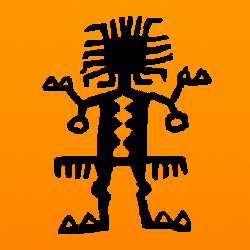
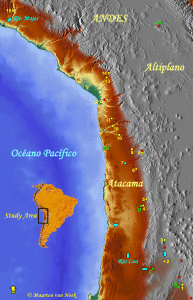
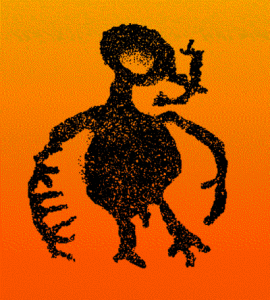

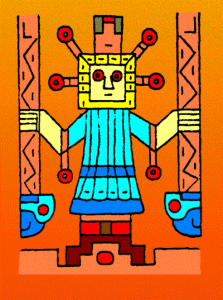
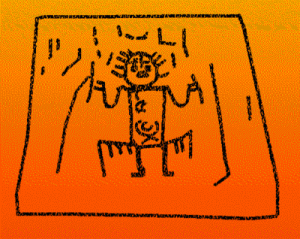
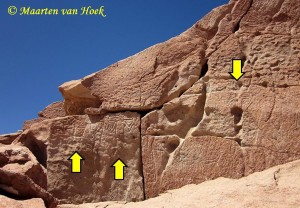
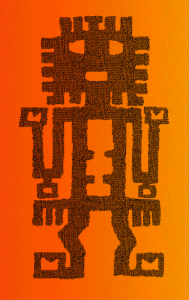
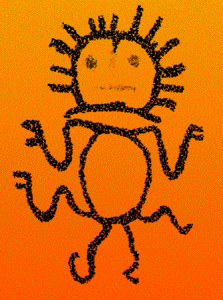
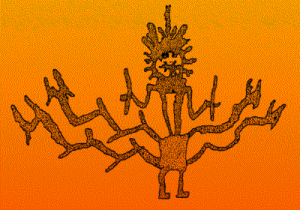
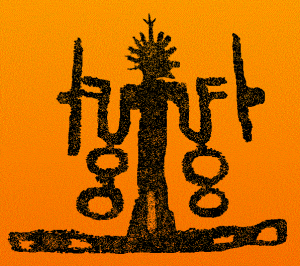
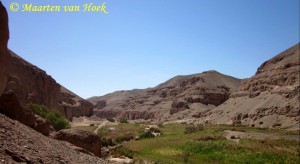
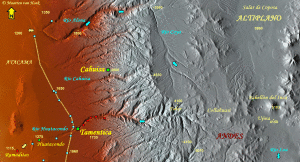
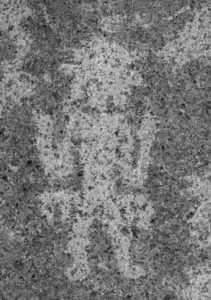
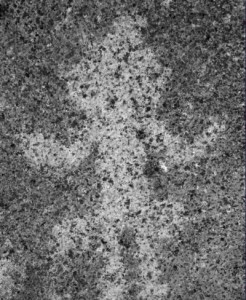
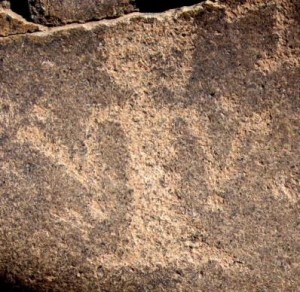
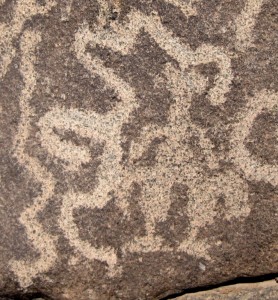
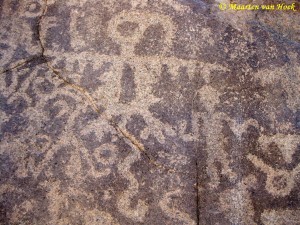
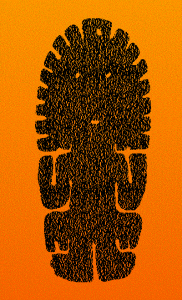
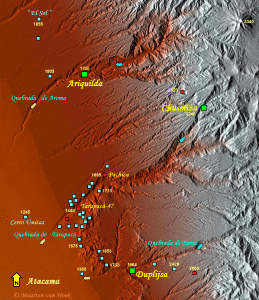
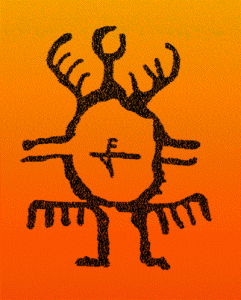
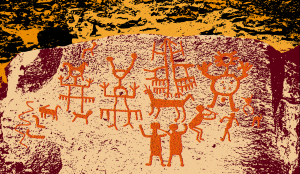

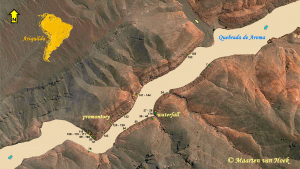
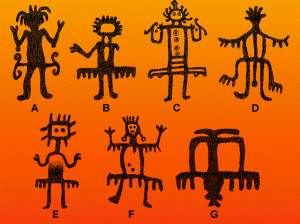
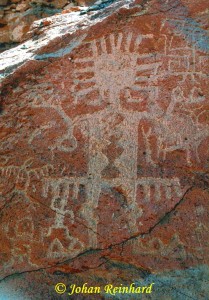
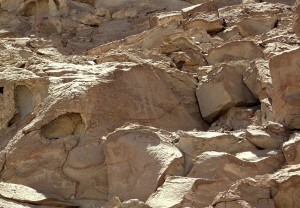
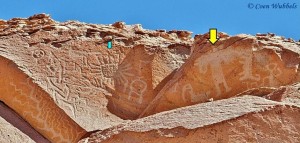
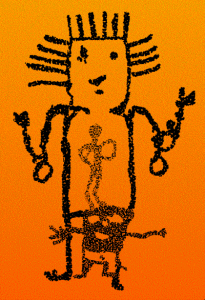
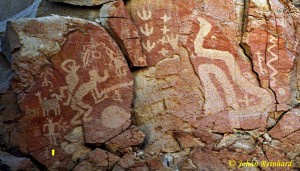
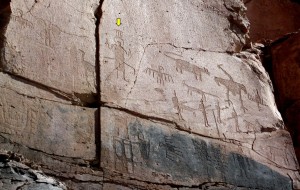
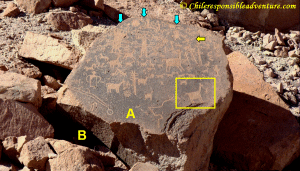
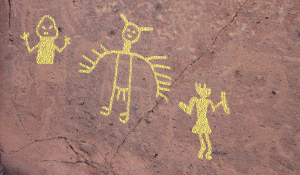
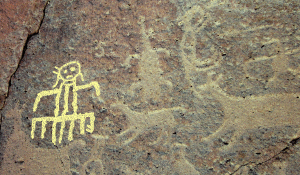
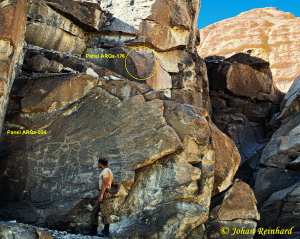
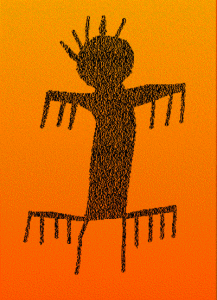
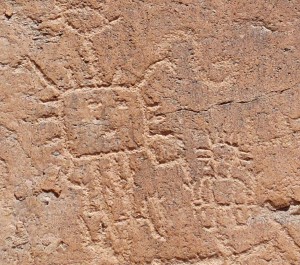
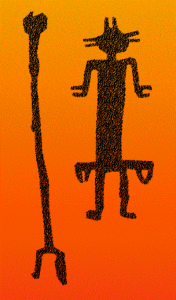
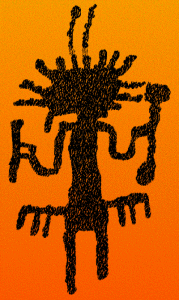

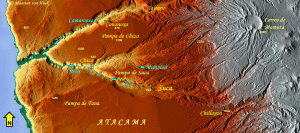
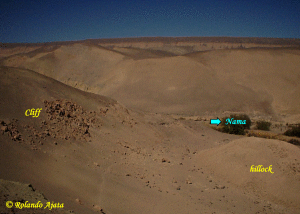
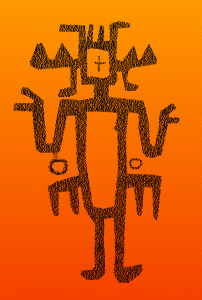
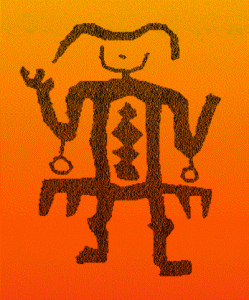
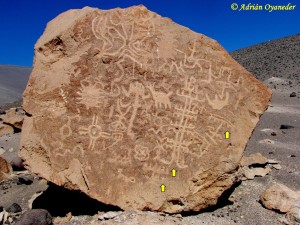
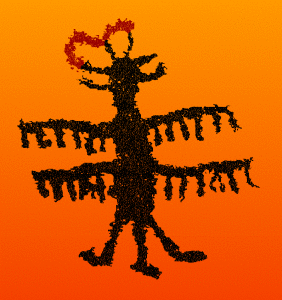
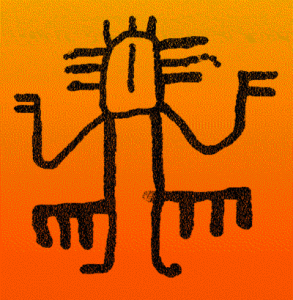
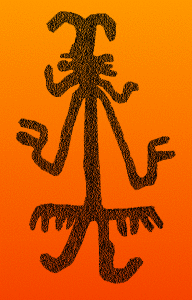
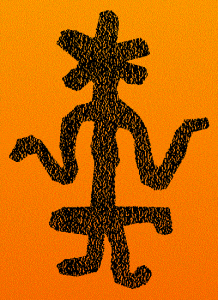
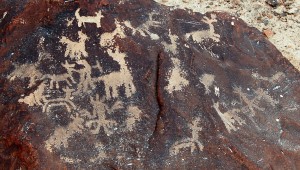
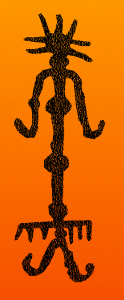
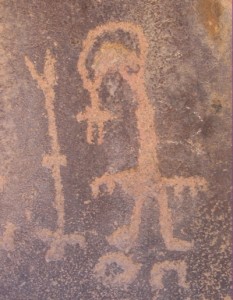
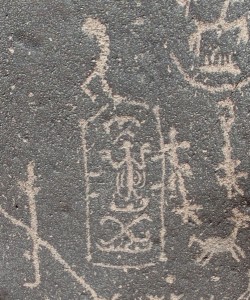
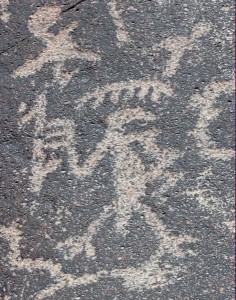
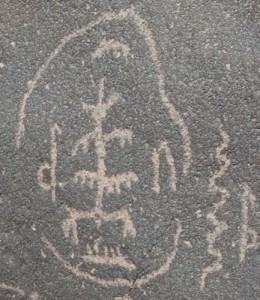
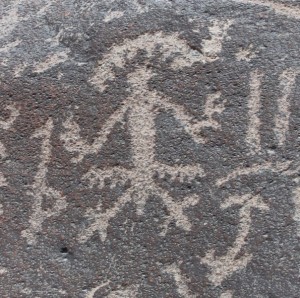
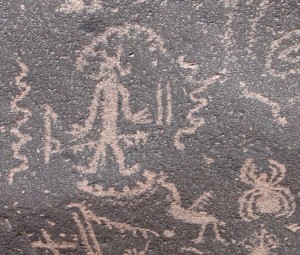
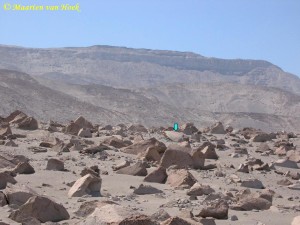
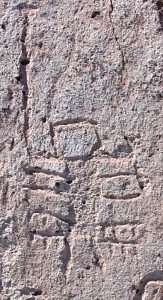
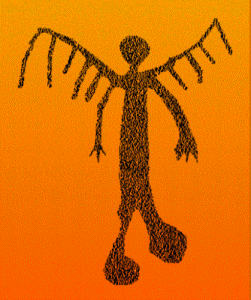
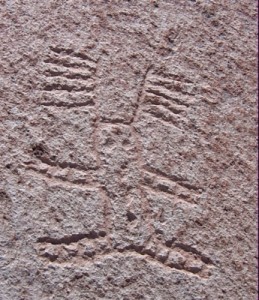
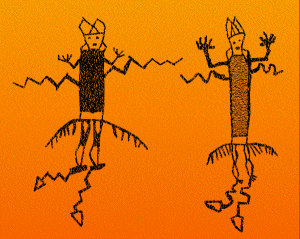
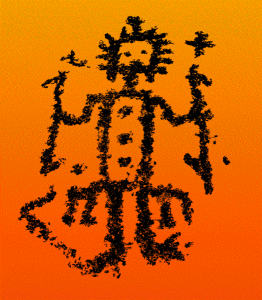
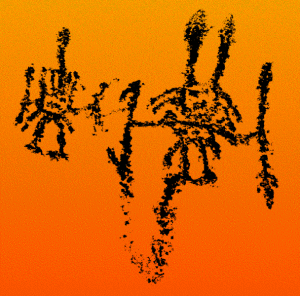
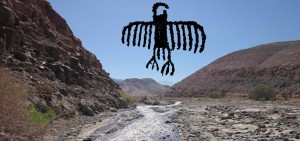
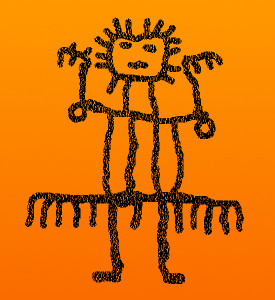
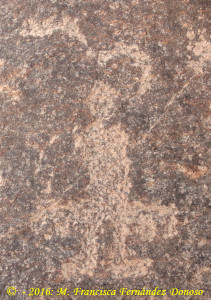
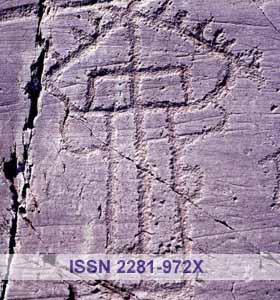













Where there is form, there is content.
Wings on petroglyphs you say? From an artist’s perspective, it all makes sense to me. Your tremendous amount of research and documentation is impressive and persuasive to say the least. Unfortunately, I’m just a layperson, so my opinion means nothing to the scientific community. Fortunately, I live a few miles from a magnificent site in the Gila Wilderness of New Mexico, U.S., where there are at least 20 or more ‘thunderbird’ petroglyphs at one site. If I find one with a ‘skirt’ I will let you know.
With all due respect, may I suggest another way of isolating the symbols from the photograph? It involves the aesthetic process of highlighting the symbols by shading the background instead. I know how to make white images on a photograph look dark using basic photo-editing software, but I am not referring to that process. Instead of concentrating on the intricate details it took to make the petroglyph (the “Fifth” or Middle World image), concentrate on looking at the ‘negative’ part of the panel, or the “Underworld” element of the panel. All those shades of grey and black reflected back from the patina is but another dimension to the aspect of true prehistoric rock art created by a prehistoric culture that not only saw the bright stars, but were also religiously enchanted by the darkest forms of the “Sky-World”.
Johnny